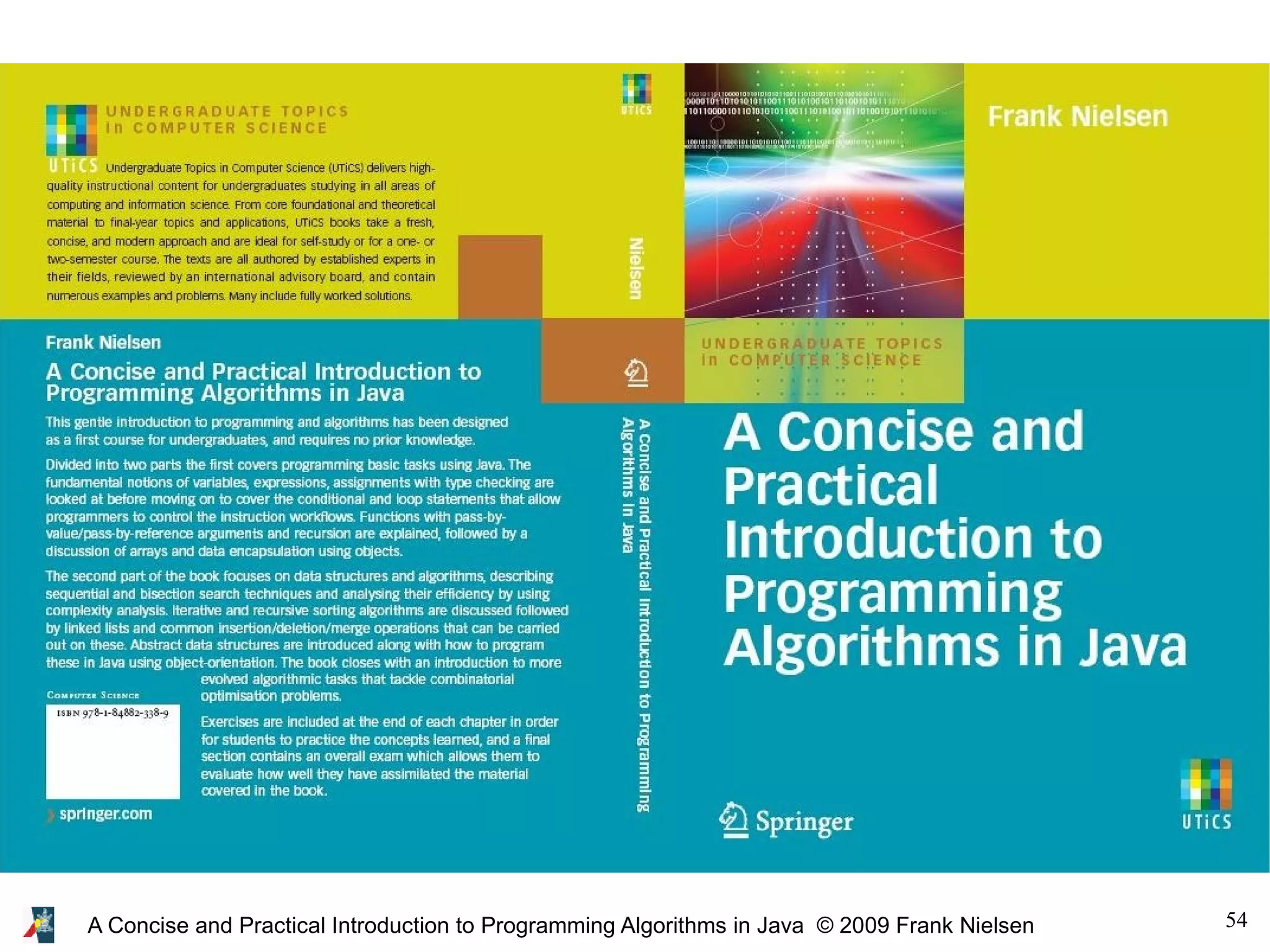The document provides a practical introduction to programming algorithms in Java, covering topics such as combinatorial optimization algorithms, including exhaustive search, greedy algorithms, and dynamic programming. It features examples of linked lists, merging ordered lists, and the eight queens puzzle, alongside optimization problems like the set cover problem. Each section discusses various algorithmic strategies and their implementations within Java code, demonstrating both theoretical concepts and practical coding techniques.
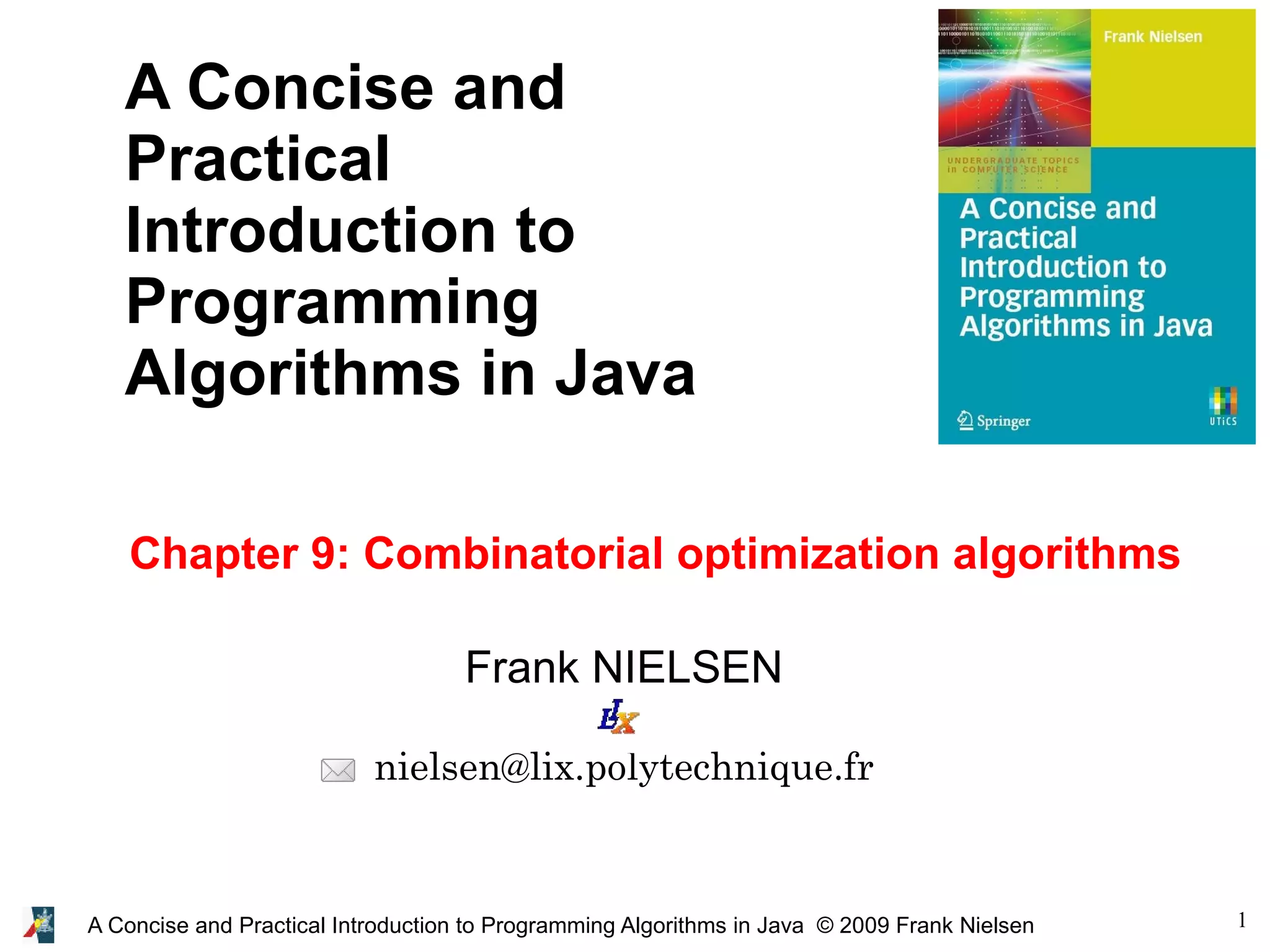
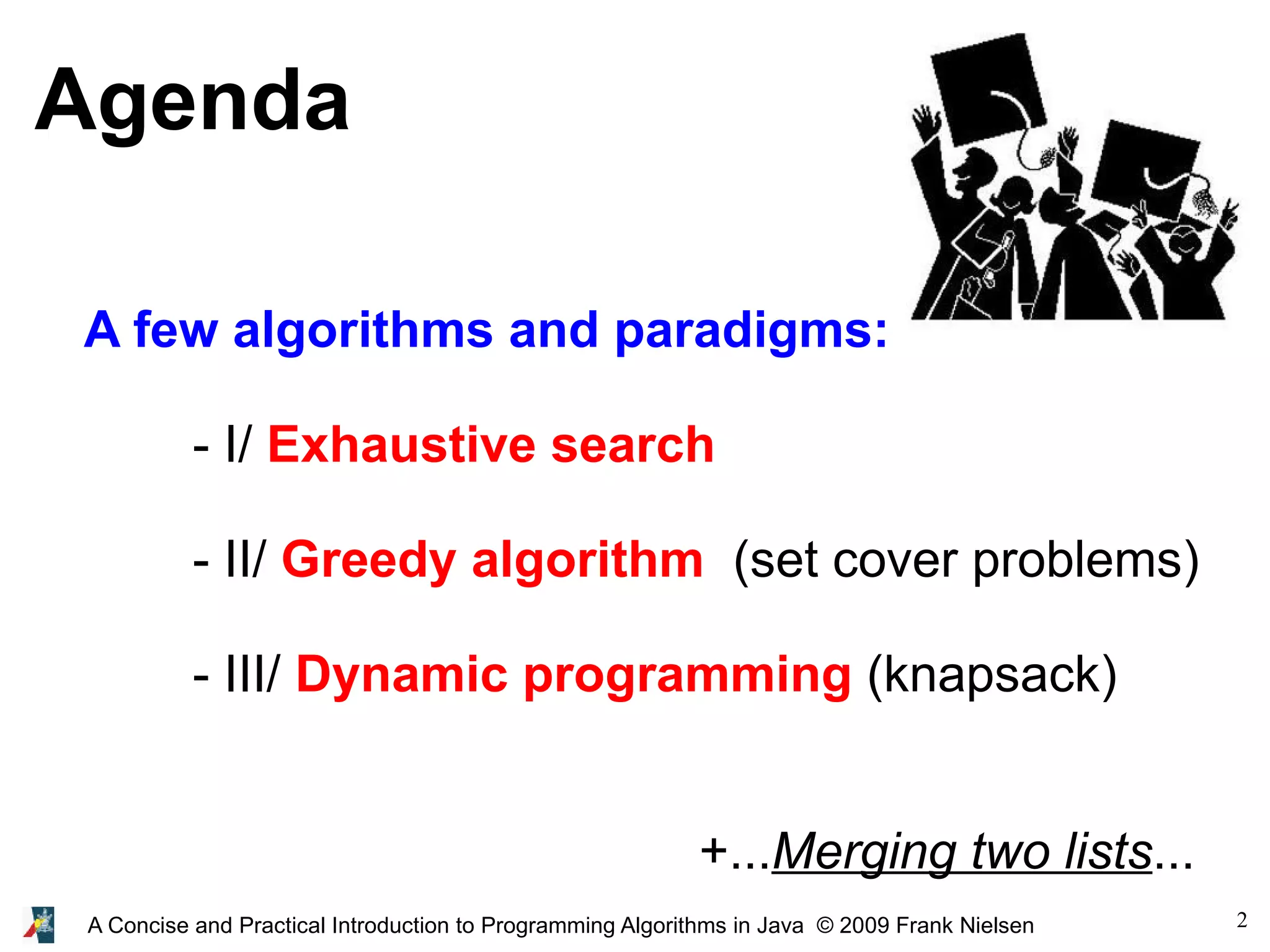
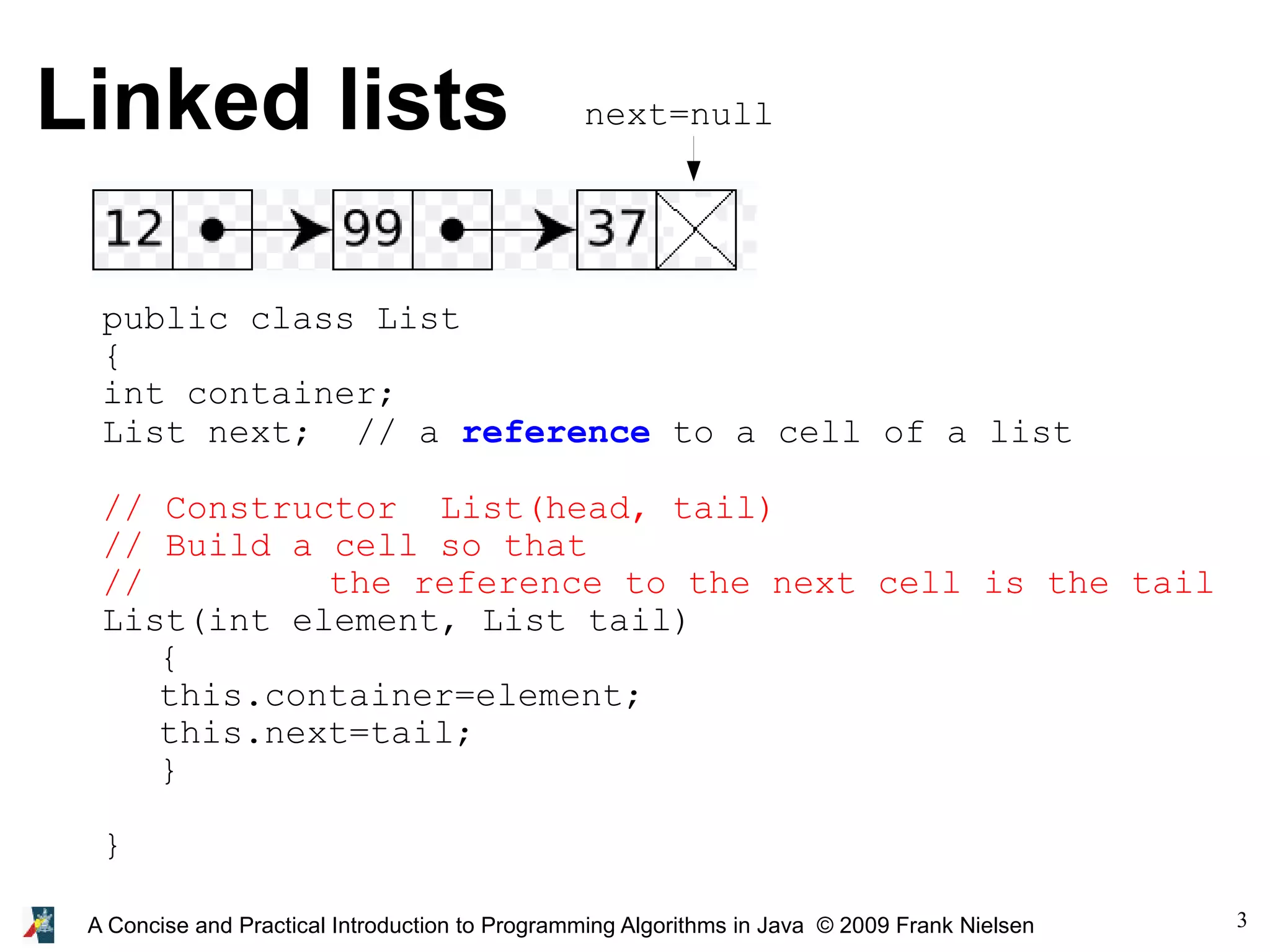
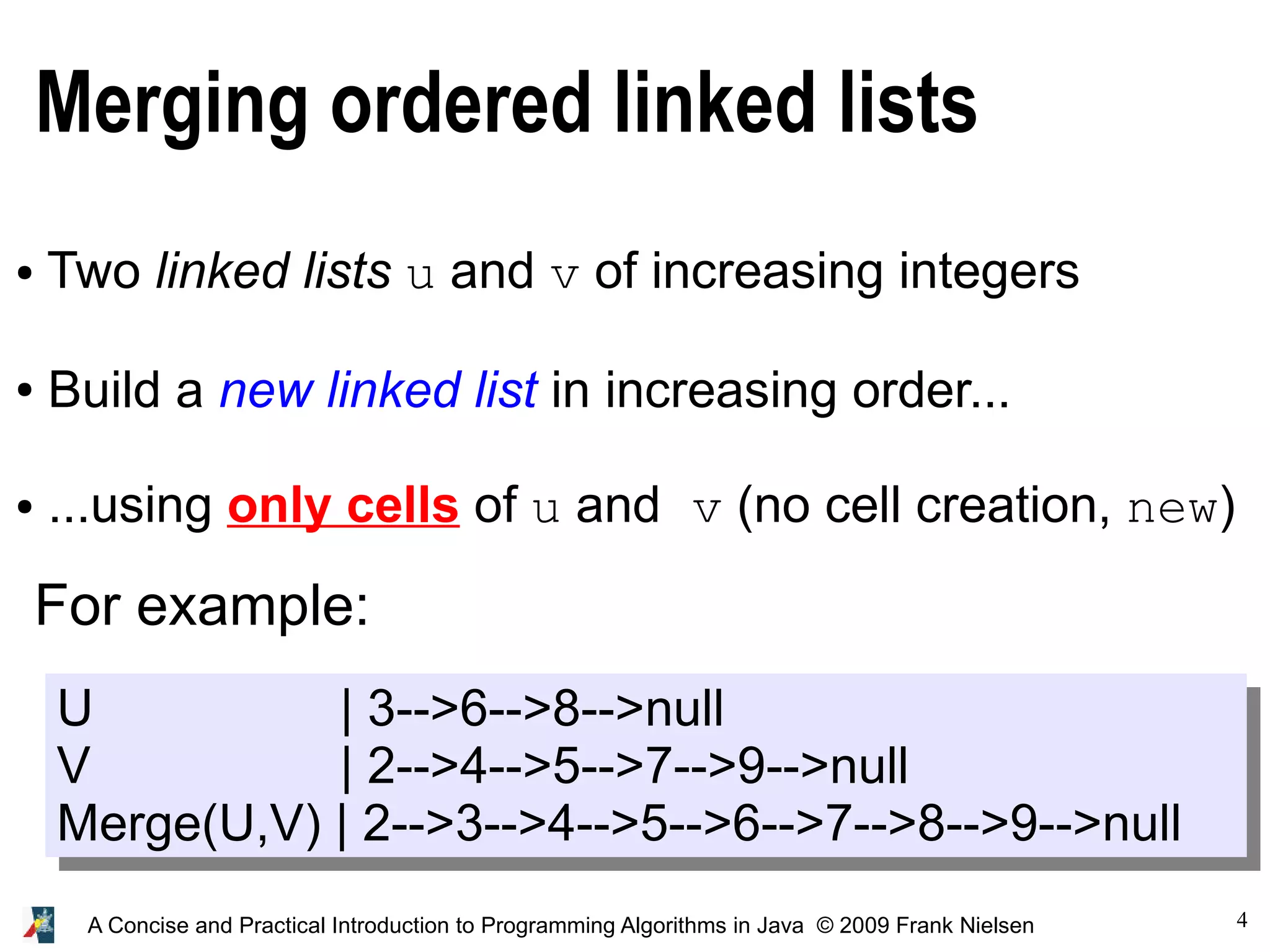
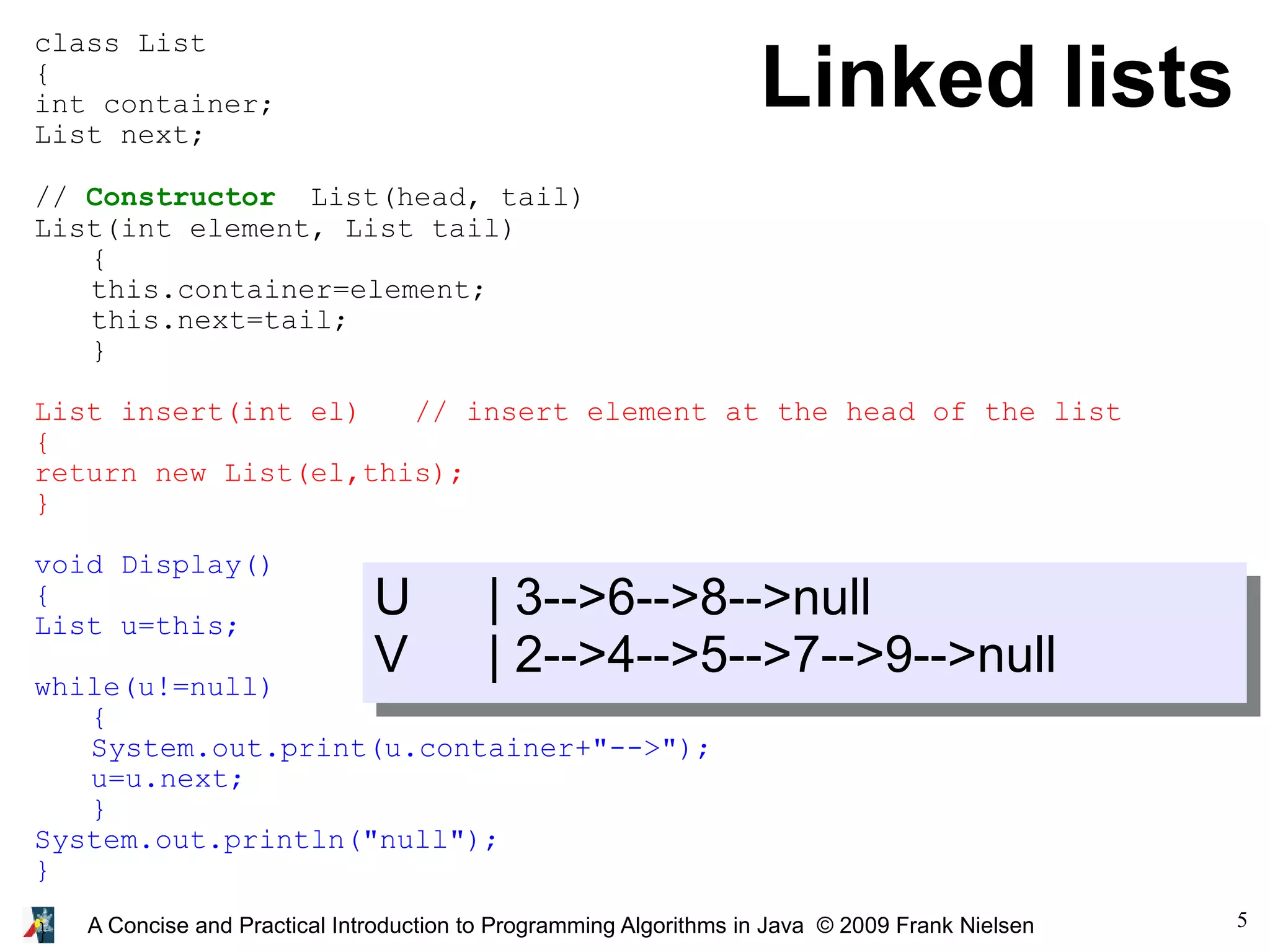
![6 A Concise and Practical Introduction to Programming Algorithms in Java © 2009 Frank Nielsen class MergeList { // // Merge two ordered lists // static List mergeRec(List u, List v) { if (u==null) return v; if (v==null) return u; if (u.container < v.container) { // Recycle cells/ no new u.next=mergeRec(u.next,v); return u; } else { // Recycle cells/no new v.next=mergeRec(u,v.next); return v; } } public static void main(String [] args) { List u=new List(8,null); u=u.insert(6);u=u.insert(3); u.Display(); List v=new List(9,null); v=v.insert(7);v=v.insert(5); v=v.insert(4);v=v.insert(2); v.Display(); List w=mergeRec(u,v); w.Display(); }](https://image.slidesharecdn.com/programmingalgorithmsjava-9-140701005620-phpapp01/75/chapter-9-A-Concise-and-Practical-Introduction-to-Programming-Algorithms-in-Java-6-2048.jpg)
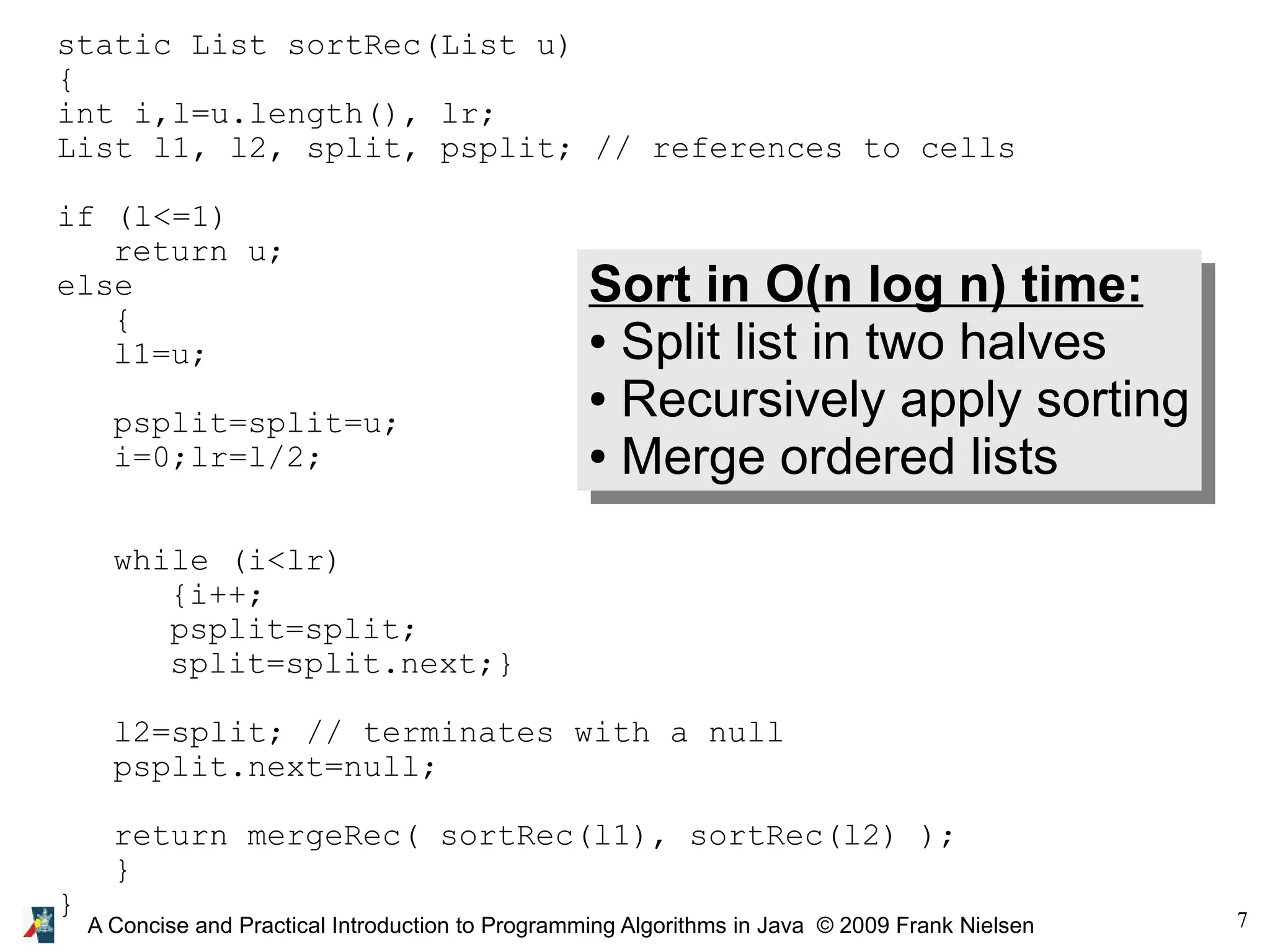
![8 A Concise and Practical Introduction to Programming Algorithms in Java © 2009 Frank Nielsen public static void main(String [] args) { List u=new List(3,null); u=u.insert(2); u=u.insert(9); u=u.insert(6);u=u.insert(1); u=u.insert(15);u=u.insert(17); u=u.insert(23);u=u.insert(21); u=u.insert(19);u=u.insert(20); u.Display(); List sortu=sortRec(u); System.out.println("Sorted linked list:"); sortu.Display(); } 20-->19-->21-->23-->17-->15-->1-->6-->9-->2-->3-->null Sorted linked list: 1-->2-->3-->6-->9-->15-->17-->19-->20-->21-->23-->null](https://image.slidesharecdn.com/programmingalgorithmsjava-9-140701005620-phpapp01/75/chapter-9-A-Concise-and-Practical-Introduction-to-Programming-Algorithms-in-Java-8-2048.jpg)
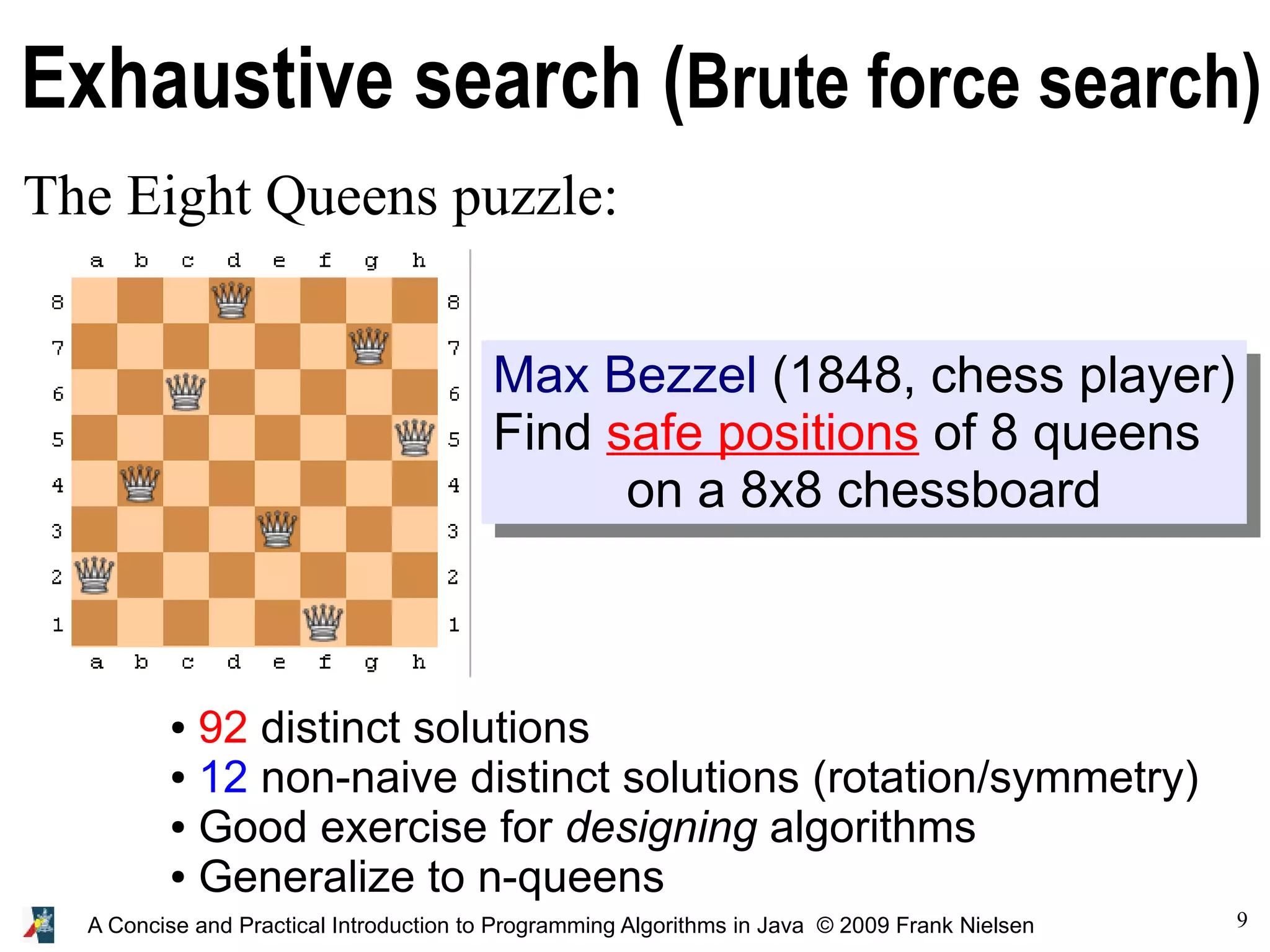
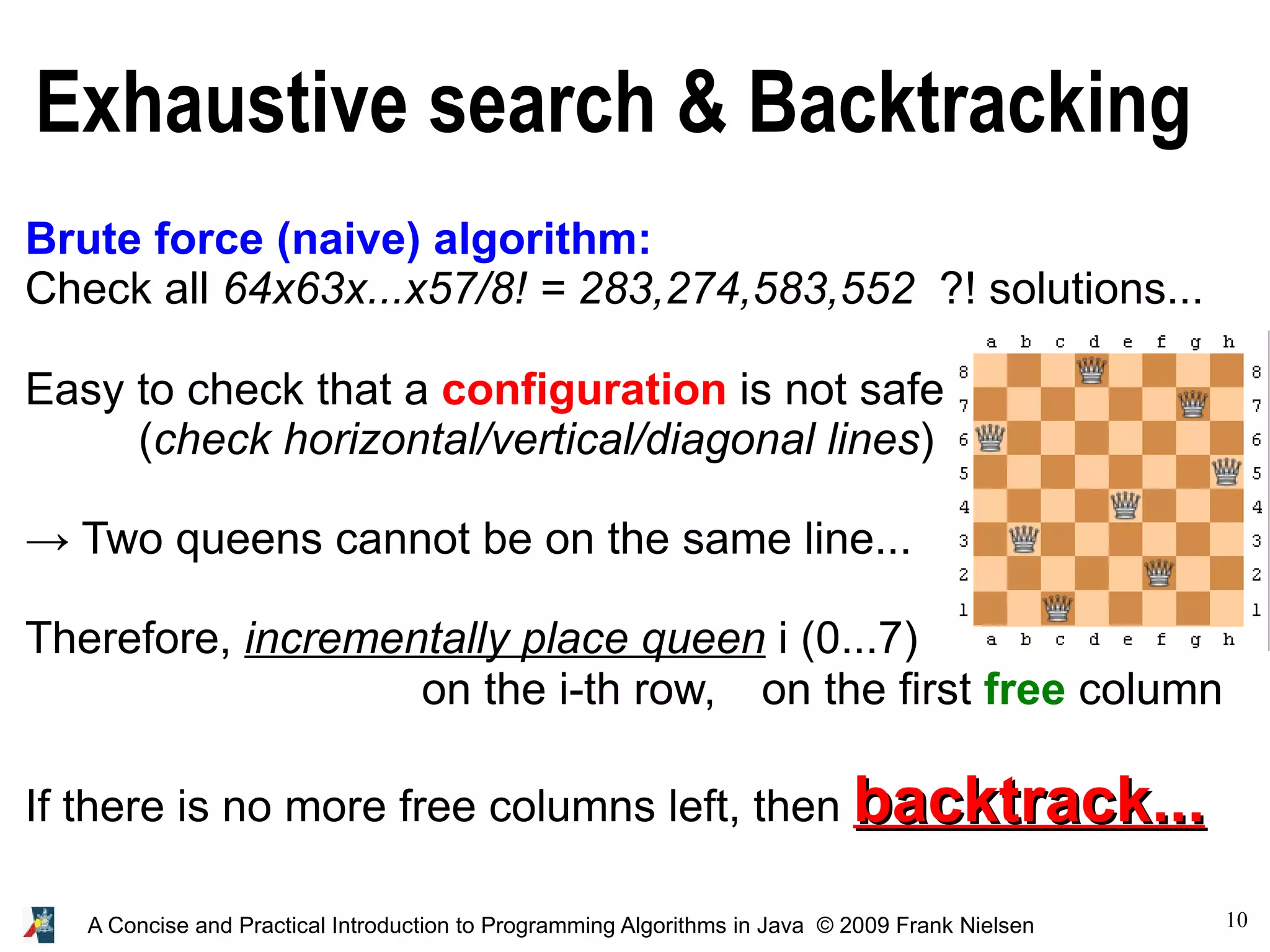
![11 A Concise and Practical Introduction to Programming Algorithms in Java © 2009 Frank Nielsen Exhaustive search & Backtracking Incrementally place queen i (0...7) on the first free column If there is no more free columns left, then backtrack: backtrack: Consider the previous queen position and increment its column position, etc., etc., etc. ... until we find a solution (=reach a successful location for queen indexed 7) queen: 1D Array that specifies the column position Queen i is located at position (i,queen[i]) (with i ranging from 0 to 7) search: Static function that returns a/all solution(s).](https://image.slidesharecdn.com/programmingalgorithmsjava-9-140701005620-phpapp01/75/chapter-9-A-Concise-and-Practical-Introduction-to-Programming-Algorithms-in-Java-11-2048.jpg)
![12 A Concise and Practical Introduction to Programming Algorithms in Java © 2009 Frank Nielsen // Are queen (i1,j1) and queen (i2,j2) safe ? static boolean WrongPos(int i1, int j1, int i2, int j2) { // same row?, same col?, same diag? return (i1==i2 || j1==j2 || Math.abs(i1-i2) == Math.abs(j1-j2)); } // Place safely queen i at column j? static boolean FreeMove(int i, int j) { boolean result=true; for(int k=0;k<i;k++) result=result&&!WrongPos(i,j,k,queen[k]); return result; } Check for the queens placed so far on the chessboard Static functions to check for collisions](https://image.slidesharecdn.com/programmingalgorithmsjava-9-140701005620-phpapp01/75/chapter-9-A-Concise-and-Practical-Introduction-to-Programming-Algorithms-in-Java-12-2048.jpg)
![13 A Concise and Practical Introduction to Programming Algorithms in Java © 2009 Frank Nielsen static boolean search(int row) { boolean result=false; if (row==n) {// Terminal case DisplayChessboard(); nbsol++; } else {// Exhaustive search int j=0; while(!result && j<n) { if (FreeMove(row,j)) { queen[row]=j; result=search(row+1); // RECURSION/BACKTRACK } j++; // explore all columns } } return result; } Increment the number of found solutions (static class variable)](https://image.slidesharecdn.com/programmingalgorithmsjava-9-140701005620-phpapp01/75/chapter-9-A-Concise-and-Practical-Introduction-to-Programming-Algorithms-in-Java-13-2048.jpg)
![14 A Concise and Practical Introduction to Programming Algorithms in Java © 2009 Frank Nielsen public static void main(String [] arguments) { nbsol=0; search(0); // Call exhaustive search procedure System.out.println("Total number of solutions:"+nbsol); } static final int n=8; static int [] queen=new int[n]; static int nbsol; static void DisplayChessboard() { int i,j; System.out.println(""); for(i=0;i<n;i++) { for(j=0;j<n;j++) { if (queen[i]!=j) System.out.print("0"); else System.out.print("1"); } System.out.println(""); } }](https://image.slidesharecdn.com/programmingalgorithmsjava-9-140701005620-phpapp01/75/chapter-9-A-Concise-and-Practical-Introduction-to-Programming-Algorithms-in-Java-14-2048.jpg)
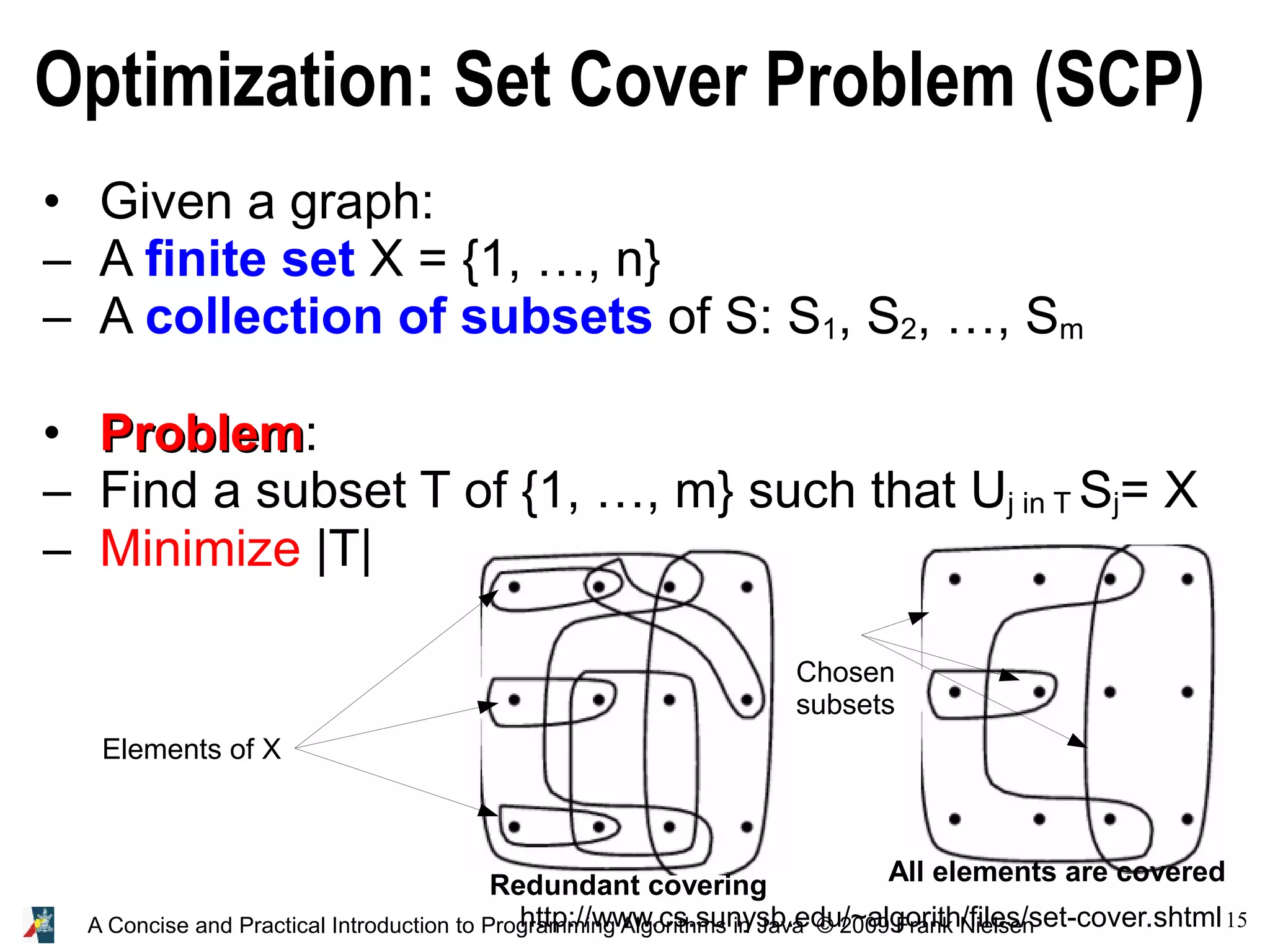
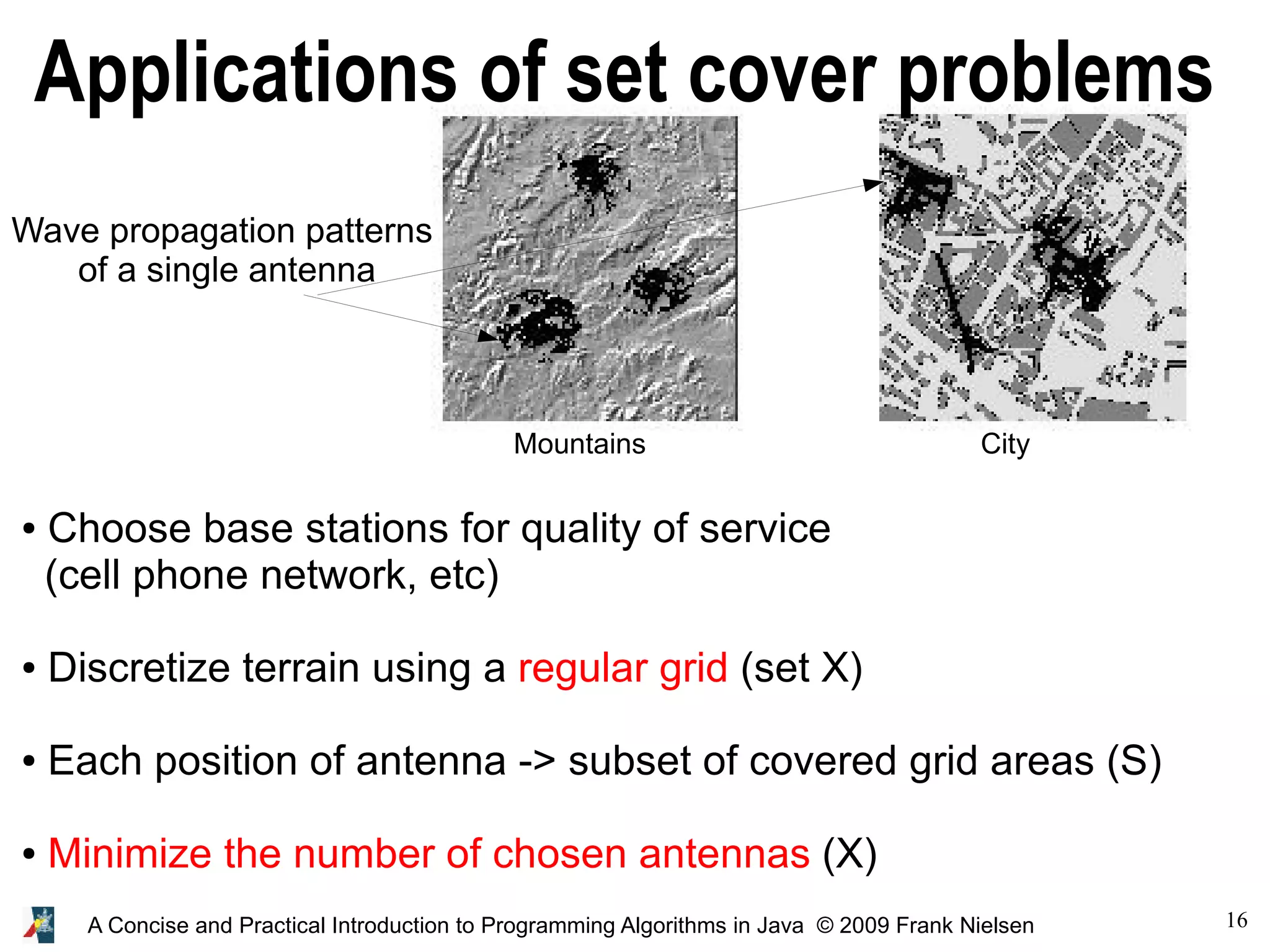
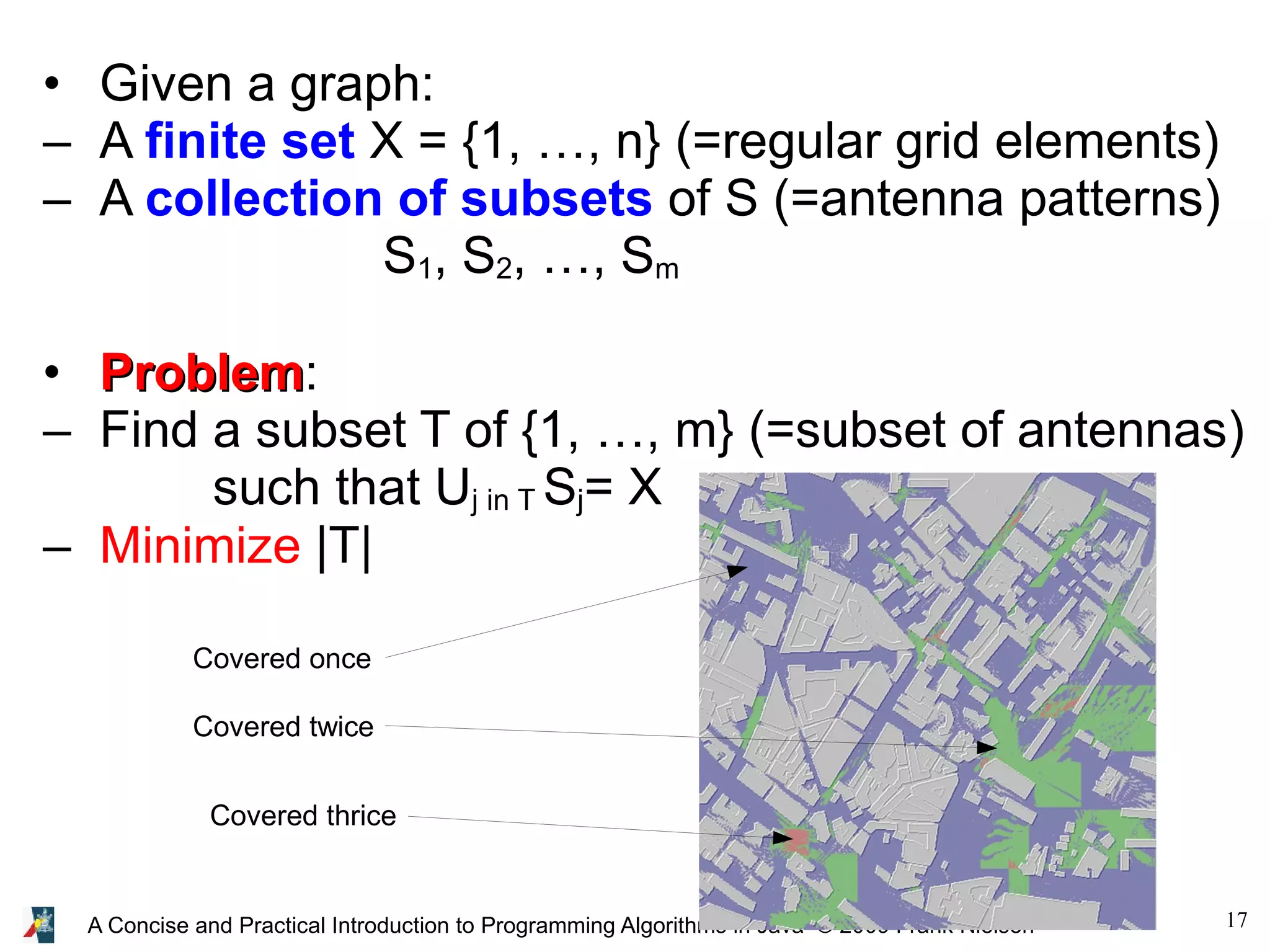
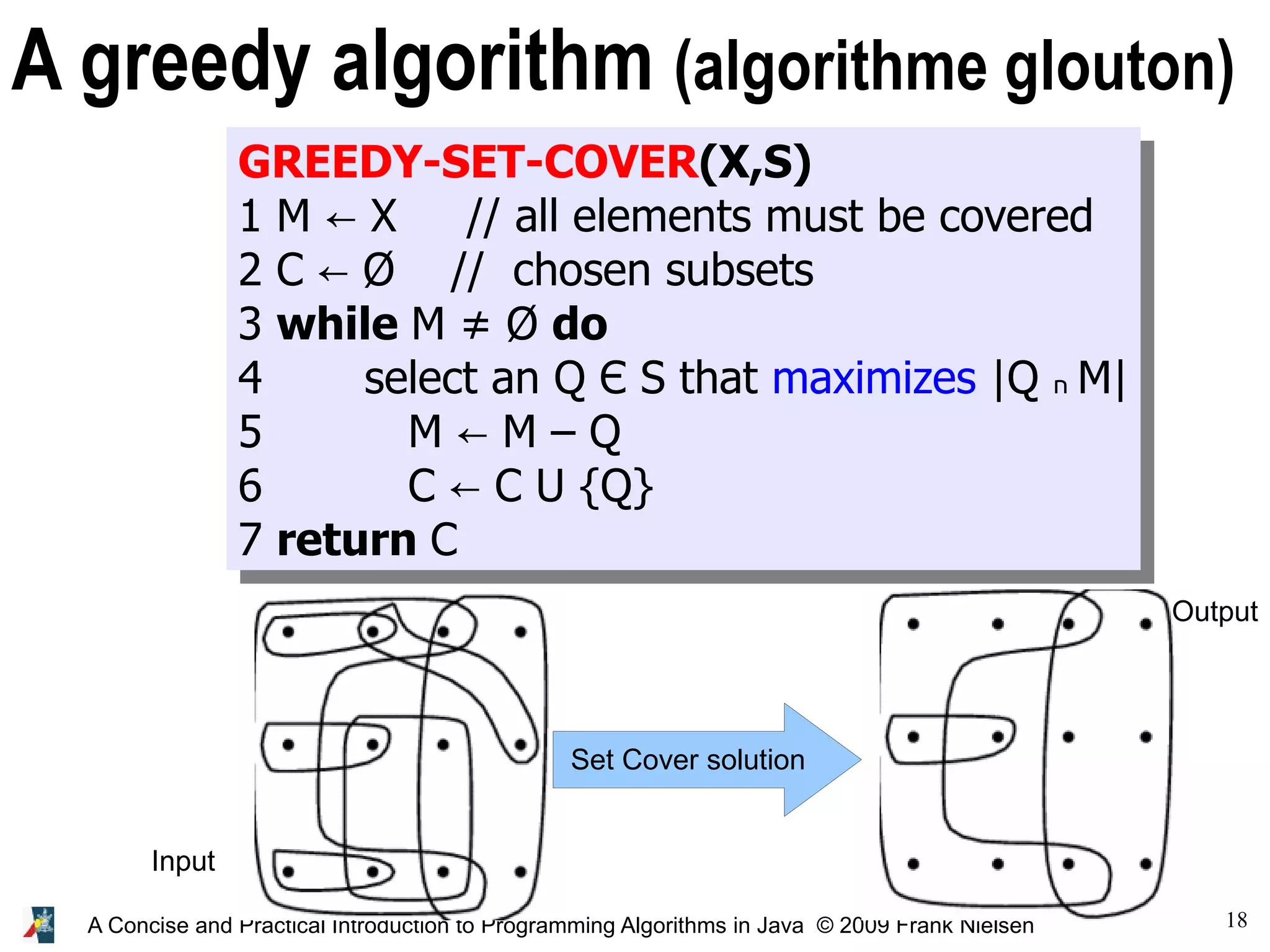
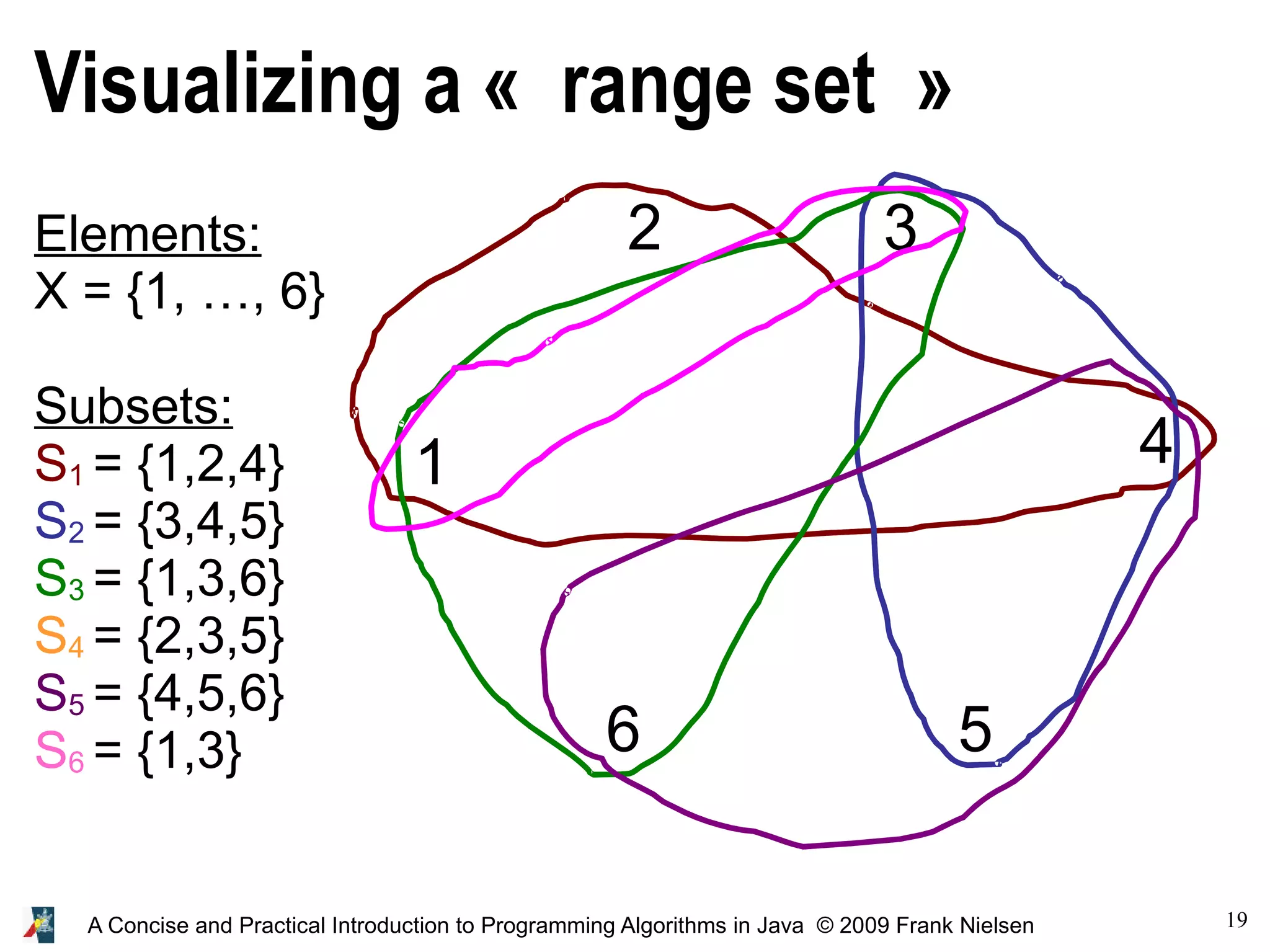
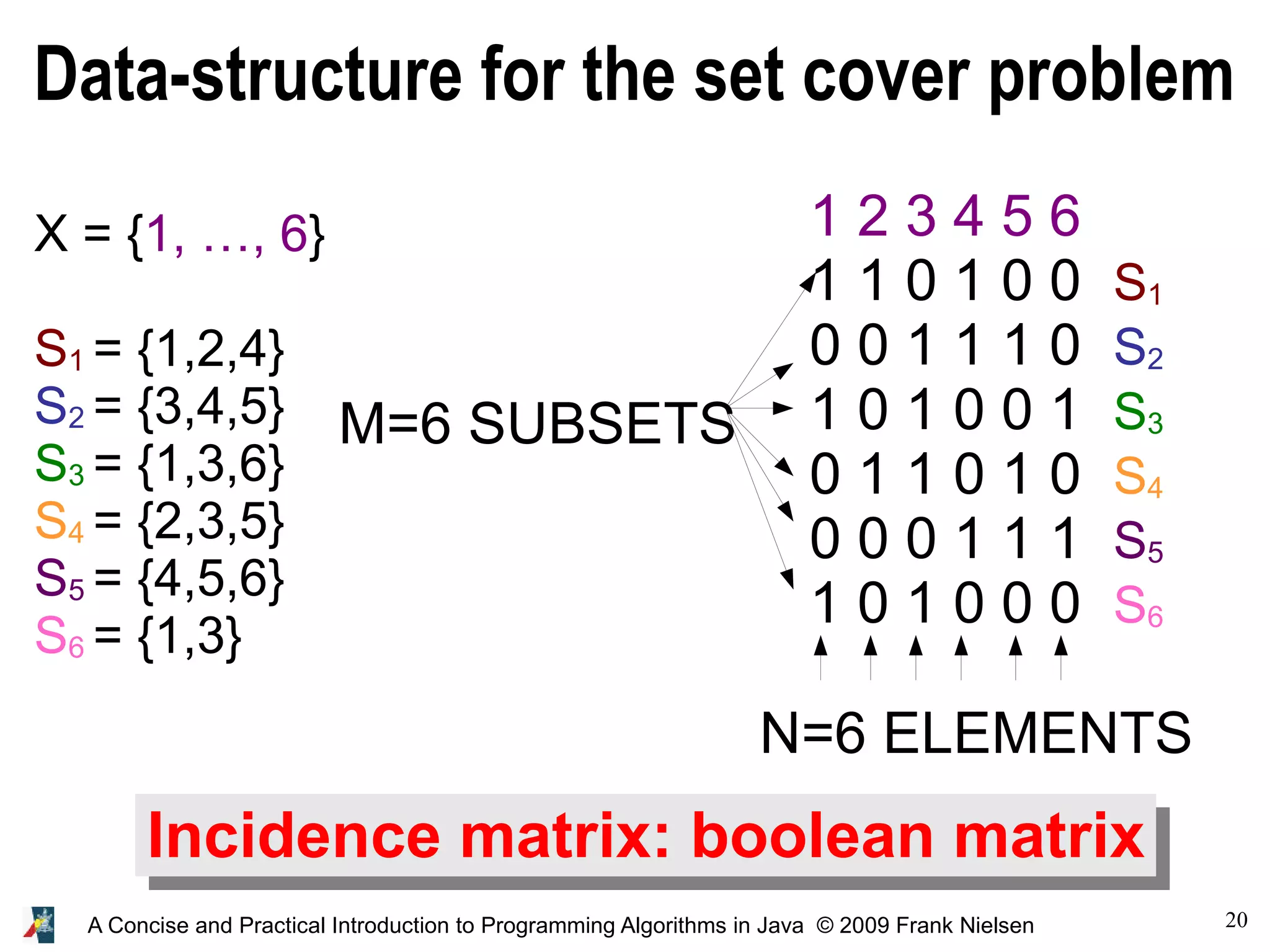
![21 A Concise and Practical Introduction to Programming Algorithms in Java © 2009 Frank Nielsen class SetCover { int nbelements; int nbsubsets; boolean [][] incidenceMatrix; //Constructor SetCover(int nn, int mm) { this.nbelements=nn; this.nbsubsets=mm; incidenceMatrix=new boolean[nbsubsets][nbelements]; for(int i=0;i<nbsubsets;i++) for(int j=0;j<nbelements;j++) incidenceMatrix[i][j]=false; } void SetSubsets(int [] [] array) // Set incidence matrix {for(int j=0;j<array.length;j++) {for(int i=0;i<array[j].length;i++) incidenceMatrix[j][array[j][i]]=true; } } }](https://image.slidesharecdn.com/programmingalgorithmsjava-9-140701005620-phpapp01/75/chapter-9-A-Concise-and-Practical-Introduction-to-Programming-Algorithms-in-Java-21-2048.jpg)
![22 A Concise and Practical Introduction to Programming Algorithms in Java © 2009 Frank Nielsen void Display() { for(int i=0;i<nbsubsets;i++){ for(int j=0;j<nbelements;j++) if (incidenceMatrix[i][j]) System.out.print("1"); else System.out.print("0"); System.out.println(""); } } public static void main(String [] args) { int [][] subsets={{0,1,3},{2,3,4}, {0,2,5},{1,2,4},{3,4,5},{0,2}}; SetCover setcover=new SetCover(6,6); setcover.SetSubsets(subsets); System.out.println("Set cover problem:"); setcover.Display(); }](https://image.slidesharecdn.com/programmingalgorithmsjava-9-140701005620-phpapp01/75/chapter-9-A-Concise-and-Practical-Introduction-to-Programming-Algorithms-in-Java-22-2048.jpg)
![23 A Concise and Practical Introduction to Programming Algorithms in Java © 2009 Frank Nielsen static boolean [] GreedySCP(SetCover problem) { boolean [] result=new boolean[problem.nbsubsets]; int cover=0; int select; for(int i=0;i<problem.nbsubsets;i++) // initially no subsets result[i]=false; while(cover!=problem.nbelements) { // Choose largest not-yet covered subset select=problem.LargestSubset(); result[select]=true; // Update covered matrix cover+=problem.Cover(select); // Update incidence matrix problem.Update(select); System.out.println("Selected "+select+" Number of covered elements="+cover); problem.Display(); } return result; } Greedy algorithm](https://image.slidesharecdn.com/programmingalgorithmsjava-9-140701005620-phpapp01/75/chapter-9-A-Concise-and-Practical-Introduction-to-Programming-Algorithms-in-Java-23-2048.jpg)
![24 A Concise and Practical Introduction to Programming Algorithms in Java © 2009 Frank Nielsen // Number of covered element by subset i int Cover(int i) { int nbEl=0; for(int j=0;j<nbelements;j++) if (incidenceMatrix[i][j]) ++nbEl; return nbEl; } // Report the current largest subset int LargestSubset() { int i, nbel, max, select; max=-1;select=-1; for(i=0;i<nbsubsets;i++) { nbel=Cover(i); if (nbel>max) {max=nbel; select=i;} } return select; } Methods of class SetCover](https://image.slidesharecdn.com/programmingalgorithmsjava-9-140701005620-phpapp01/75/chapter-9-A-Concise-and-Practical-Introduction-to-Programming-Algorithms-in-Java-24-2048.jpg)
![25 A Concise and Practical Introduction to Programming Algorithms in Java © 2009 Frank Nielsen Methods of class SetCover // Update the incidence matrix void Update(int sel) { int i,j; for(i=0;i<nbsubsets;i++) { if (i!=sel) //use sel below so don't modify it { for(j=0;j<nbelements;j++) if (incidenceMatrix[sel][j]) incidenceMatrix[i][j]=false; } } // Remove the chosen subset as well for(j=0;j<nbelements;j++) incidenceMatrix[sel][j]=false; }](https://image.slidesharecdn.com/programmingalgorithmsjava-9-140701005620-phpapp01/75/chapter-9-A-Concise-and-Practical-Introduction-to-Programming-Algorithms-in-Java-25-2048.jpg)
![26 A Concise and Practical Introduction to Programming Algorithms in Java © 2009 Frank Nielsen public static void main(String [] args) { int [] [] subsets ={{0,1,3},{2,3,4}, {0,2,5},{1,2,4}, {3,4,5},{0,2}}; SetCover setcover=new SetCover(6,6); setcover.SetSubsets(subsets); System.out.println("Set cover problem:"); setcover.Display(); boolean [] solution=GreedySCP(setcover); System.out.print("Solution:"); for(int i=0;i<setcover.nbsubsets;i++) if (solution[i]) System.out.print(" "+i); System.out.println(""); } Set cover problem: 110100 001110 101001 011010 000111 101000 Selected 0 Number of covered elements=3 000000 001010 001001 001010 000011 001000 Selected 1 Number of covered elements=5 000000 000000 000001 000000 000001 000000 Selected 2 Number of covered elements=6 000000 000000 000000 000000 000000 000000 Solution: 0 1 2](https://image.slidesharecdn.com/programmingalgorithmsjava-9-140701005620-phpapp01/75/chapter-9-A-Concise-and-Practical-Introduction-to-Programming-Algorithms-in-Java-26-2048.jpg)
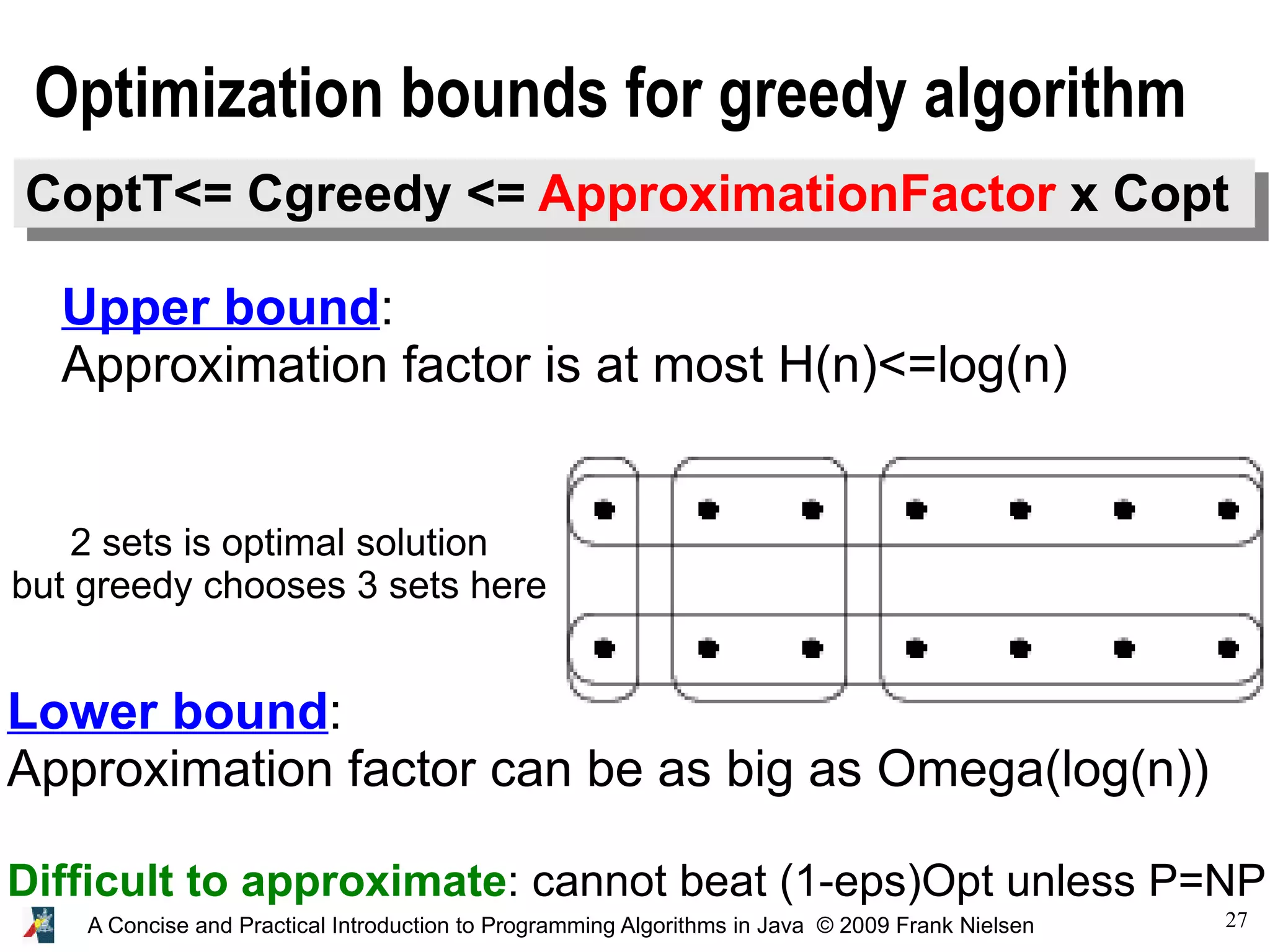
![28 A Concise and Practical Introduction to Programming Algorithms in Java © 2009 Frank Nielsen int [] [] subsets={{0,1,2,3,4,5,6},{7,8,9,10,11,12,13}, {0,7},{1,2,8,9},{3,4,5,6,10,11,12,13}}; SetCover setcover=new SetCover(14,5); Set cover problem: 11111110000000 00000001111111 10000001000000 01100000110000 00011110001111 Selected 4 Number of covered elements=8 11100000000000 00000001110000 10000001000000 01100000110000 00000000000000 Selected 3 Number of covered elements=12 10000000000000 00000001000000 10000001000000 00000000000000 00000000000000 Selected 2 Number of covered elements=14 00000000000000 00000000000000 00000000000000 00000000000000 00000000000000 Solution: 2 3 4 Etc... Easy to build generic examples where greedy does not behave well with O(log n) approximation ratio](https://image.slidesharecdn.com/programmingalgorithmsjava-9-140701005620-phpapp01/75/chapter-9-A-Concise-and-Practical-Introduction-to-Programming-Algorithms-in-Java-28-2048.jpg)
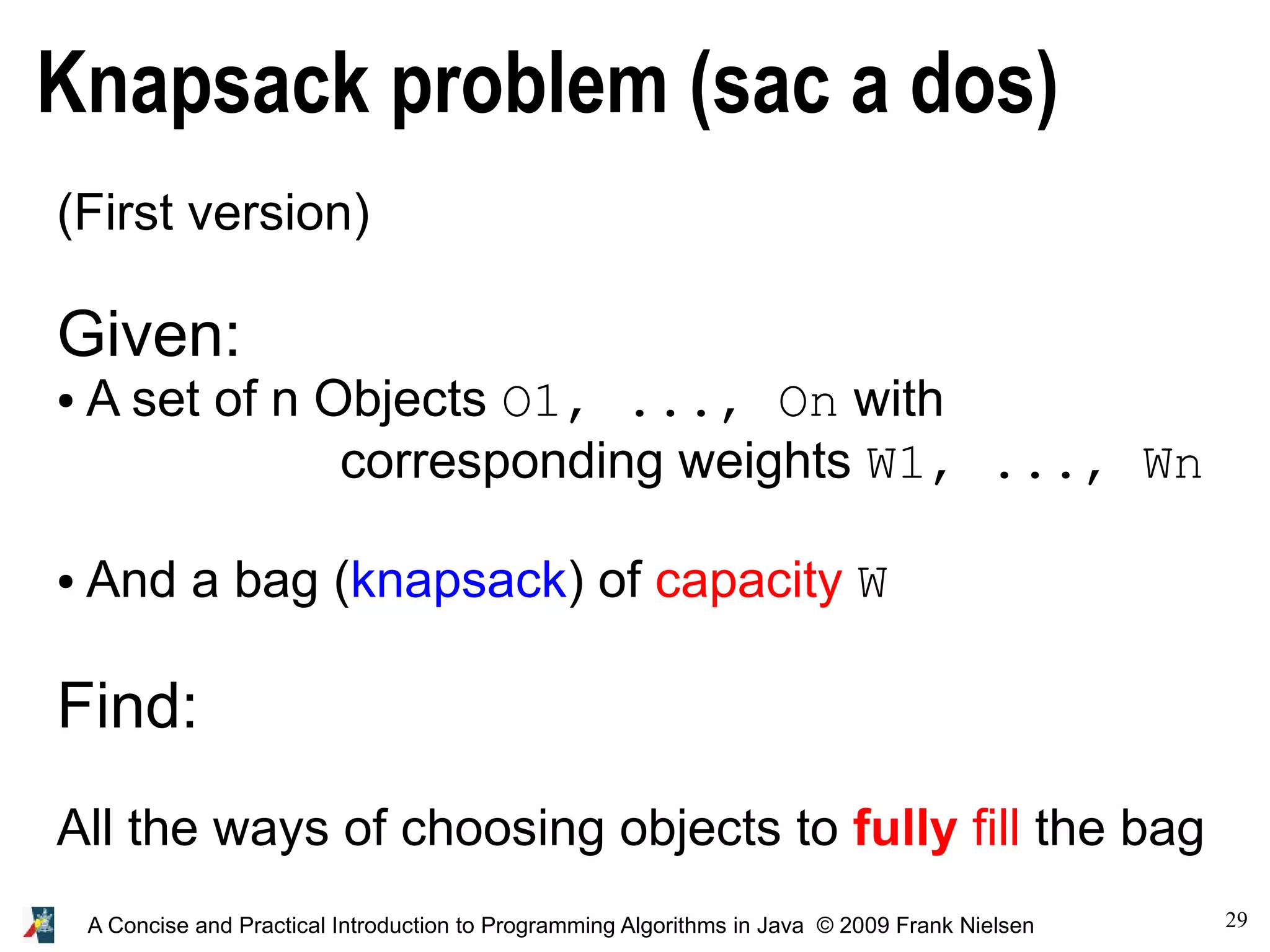
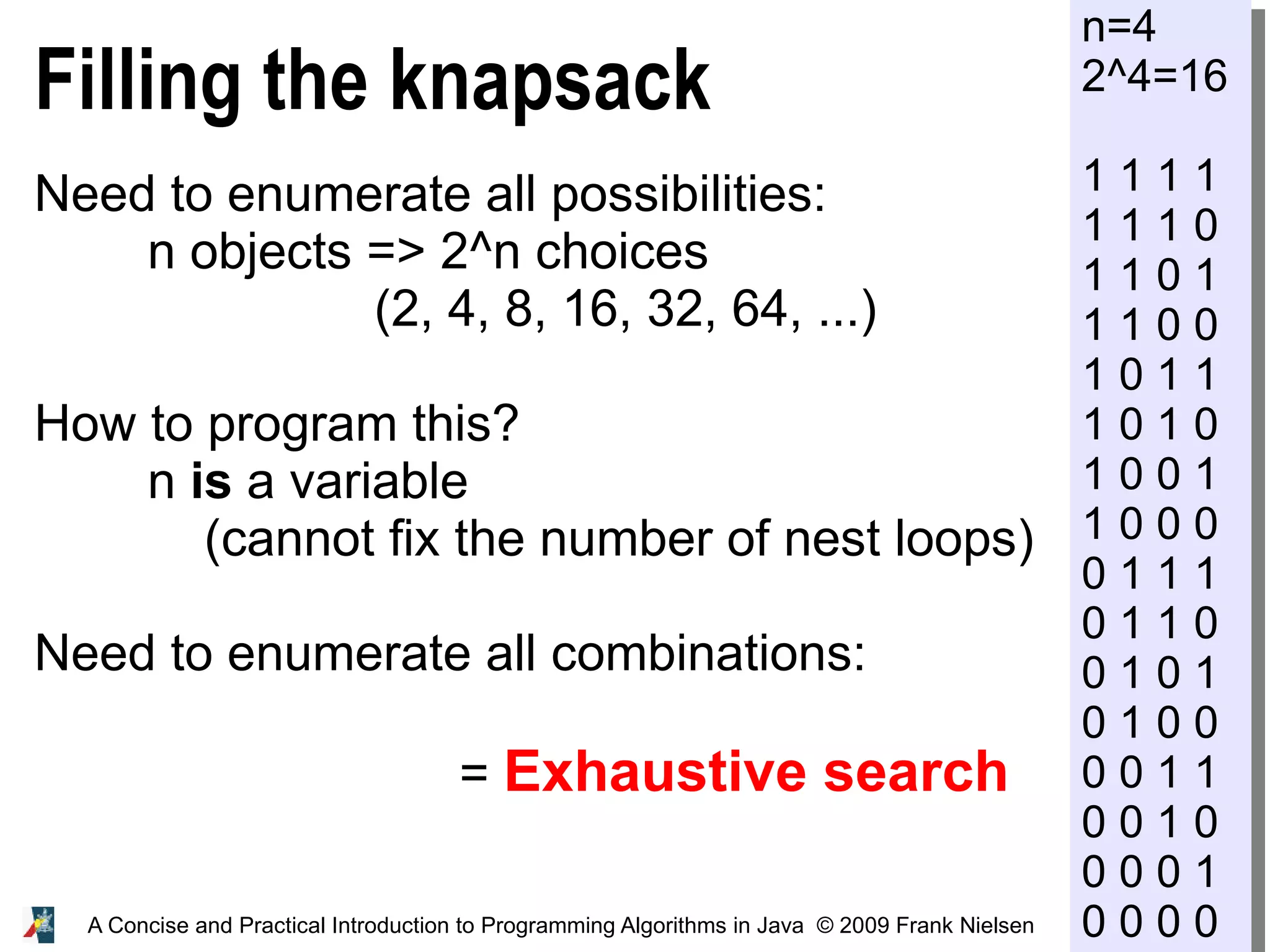
![31 A Concise and Practical Introduction to Programming Algorithms in Java © 2009 Frank Nielsen Enumerating: A recursive approach static void Display(boolean [] tab) { for(int i=0;i<tab.length;i++) if (tab[i]) System.out.print("1 "); else System.out.print("0 "); System.out.println(""); } static void Enumerate(boolean [] selection, int pos) { if (pos==selection.length-1) Display(selection); else { pos++; selection[pos]=true; Enumerate(selection,pos); selection[pos]=false; Enumerate(selection,pos); } } public static void main(String[] args) { int n=4; int i; boolean [] select=new boolean[n]; for(i=0;i<n;i++) select[i]=false; Enumerate(select,-1); }](https://image.slidesharecdn.com/programmingalgorithmsjava-9-140701005620-phpapp01/75/chapter-9-A-Concise-and-Practical-Introduction-to-Programming-Algorithms-in-Java-31-2048.jpg)
![32 A Concise and Practical Introduction to Programming Algorithms in Java © 2009 Frank Nielsen Fully filling the knapsack static void SolveKnapSack(boolean [] chosen, int goal, int i, int total) { numbercall++; // keep track of total number of calls if ((i>=chosen.length)&&(total!=goal)) return; if (total==goal) { Display(chosen, goal); numbersol++; // total number of solutions } else { chosen[i]=true;// add item first SolveKnapSack(chosen,goal,i+1,total+weight[i]); chosen[i]=false; // and then remove it SolveKnapSack(chosen,goal,i+1,total); } } final static int n=10; // 10 objects static int [] weight={2,3,5,7,9,11,4,13,23,27};](https://image.slidesharecdn.com/programmingalgorithmsjava-9-140701005620-phpapp01/75/chapter-9-A-Concise-and-Practical-Introduction-to-Programming-Algorithms-in-Java-32-2048.jpg)
![33 A Concise and Practical Introduction to Programming Algorithms in Java © 2009 Frank Nielsen final static int n=10; // 10 objects static int [] weight={2,3,5,7,9,11,4,13,23,27}; public static void main(String [] args) { int totalweight=51; numbersol=0; numbercall=0; System.out.println("Knapsack:"); boolean [] chosen=new boolean[n]; SolveKnapSack(chosen, totalweight, 0, 0); System.out.println("Total number of solutions:"+numbersol); System.out.println(" #calls="+numbercall); } Knapsack: 2+3+5+7+11+23+0=51 2+5+7+9+11+4+13+0=51 2+5+4+13+27+0=51 2+7+11+4+27+0=51 2+9+4+13+23+0=51 2+9+13+27+0=51 3+5+7+9+4+23+0=51 3+5+7+9+27+0=51 3+5+7+13+23+0=51 3+5+9+11+23+0=51 7+4+13+27+0=51 9+11+4+27+0=51 11+4+13+23+0=51 11+13+27+0=51 Total number of solutions:14 #calls=2029](https://image.slidesharecdn.com/programmingalgorithmsjava-9-140701005620-phpapp01/75/chapter-9-A-Concise-and-Practical-Introduction-to-Programming-Algorithms-in-Java-33-2048.jpg)
![34 A Concise and Practical Introduction to Programming Algorithms in Java © 2009 Frank Nielsen Exhaustive search: Branch & bound static void SolveKnapSack(boolean [] chosen, int goal, int i, int total) { numbercall++; if (total>goal) return; // cut if ((i>=chosen.length)&&(total!=goal)) return; if (total==goal) { Display(chosen, goal); numbersol++; } else { chosen[i]=true;// add item first SolveKnapSack(chosen,goal,i+1,total+weight[i]); chosen[i]=false; // and then remove it SolveKnapSack(chosen,goal,i+1,total); } } Stop recursion if we already exceed the weight amount](https://image.slidesharecdn.com/programmingalgorithmsjava-9-140701005620-phpapp01/75/chapter-9-A-Concise-and-Practical-Introduction-to-Programming-Algorithms-in-Java-34-2048.jpg)
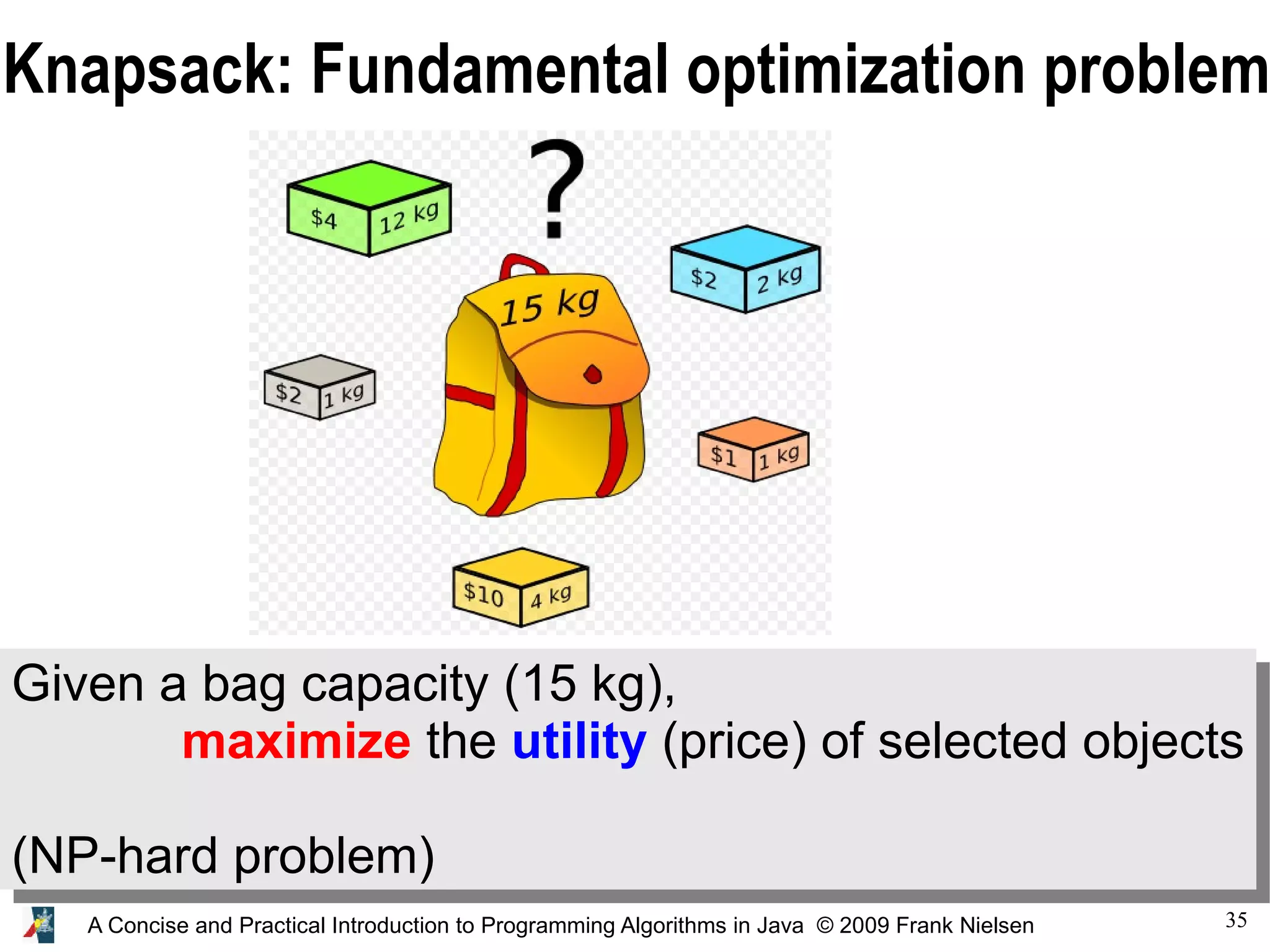
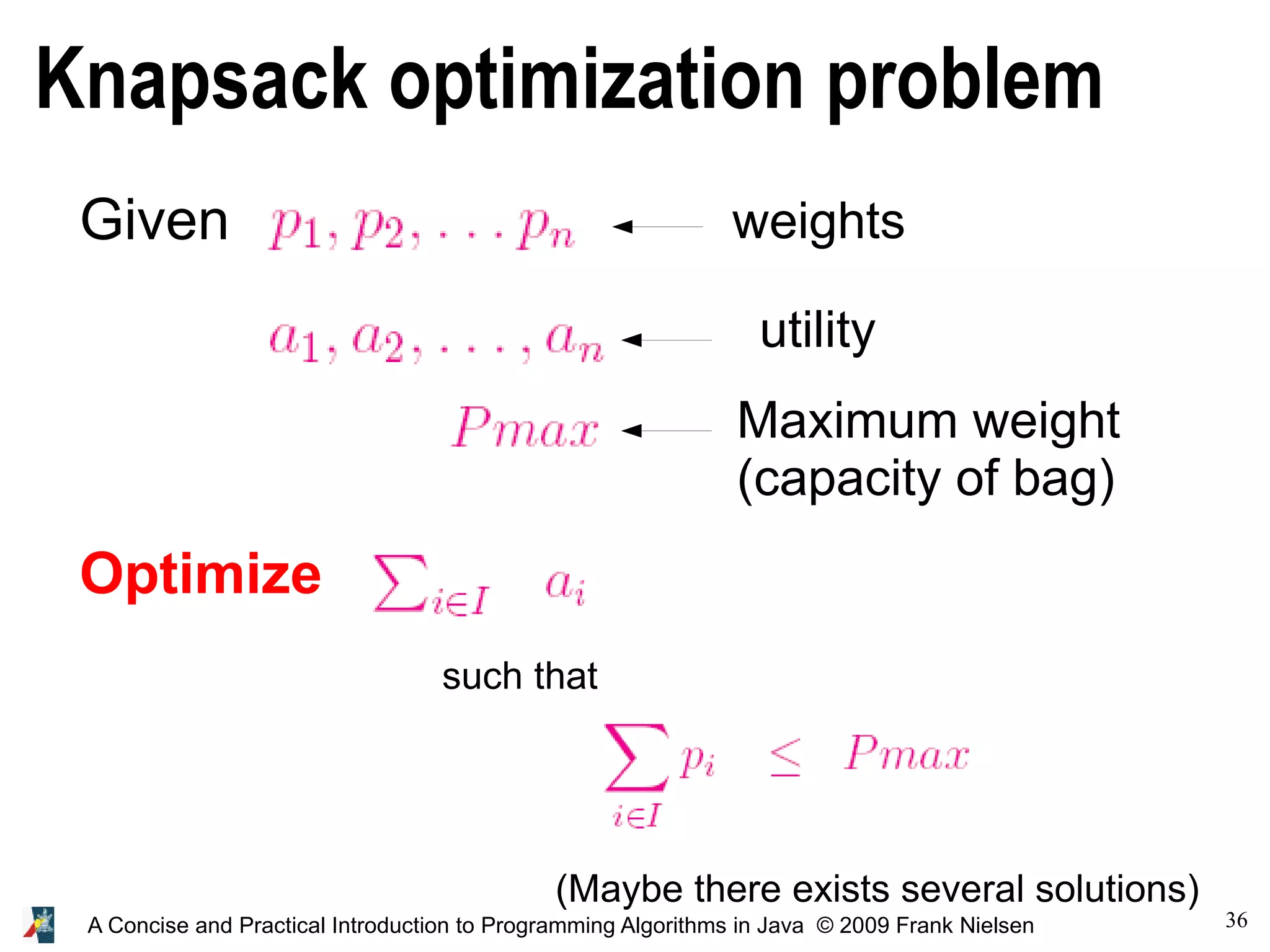
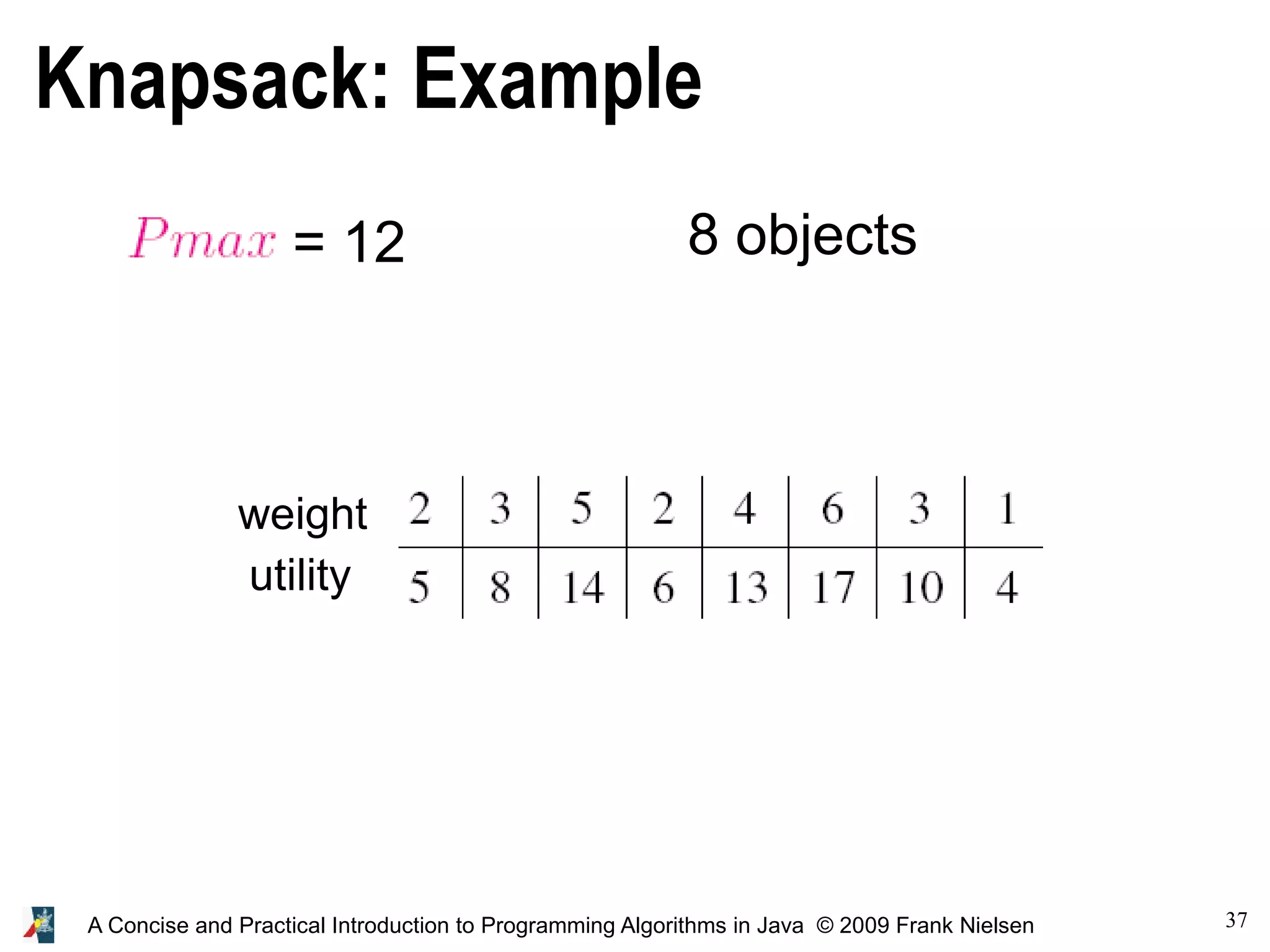
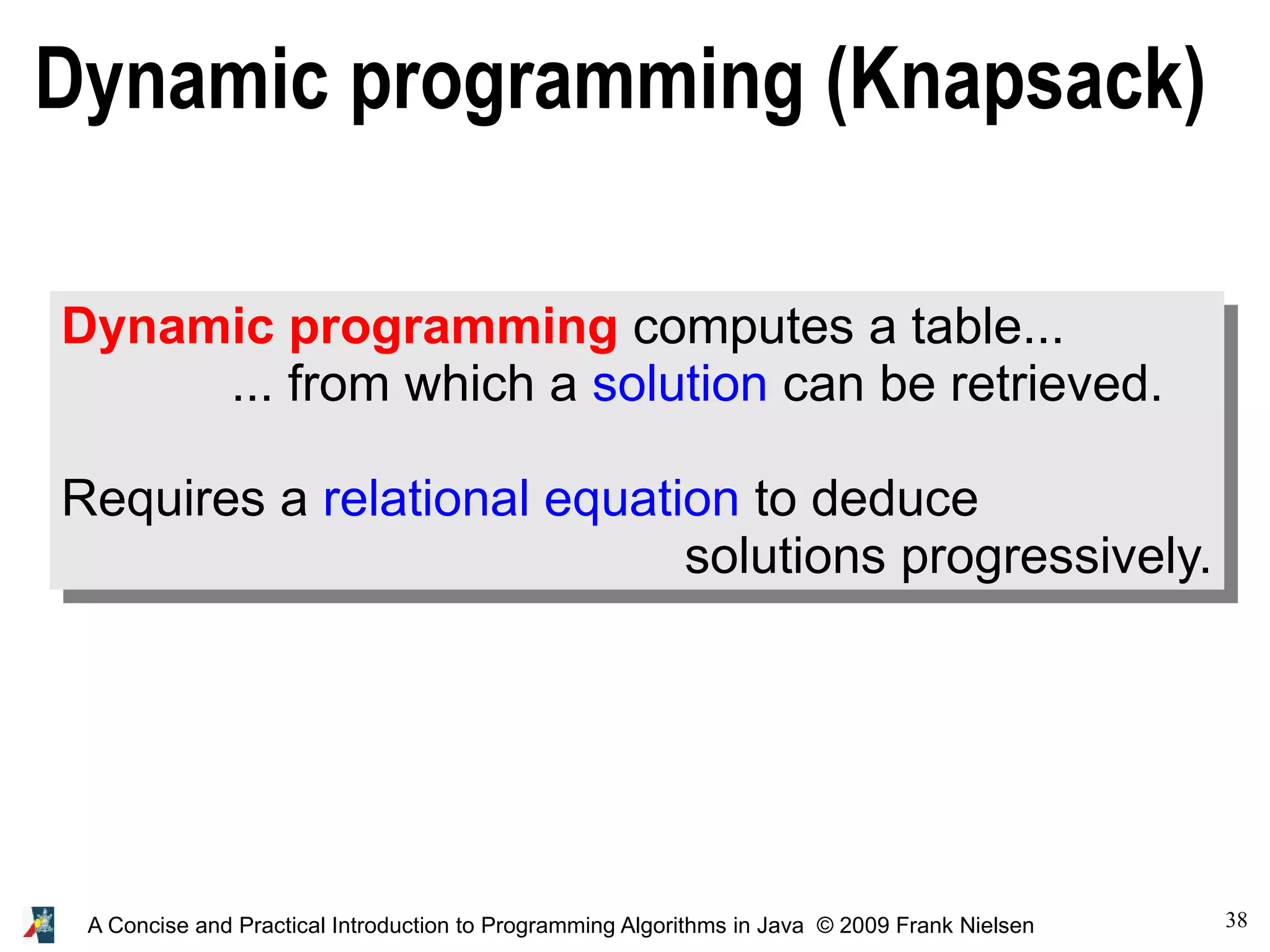
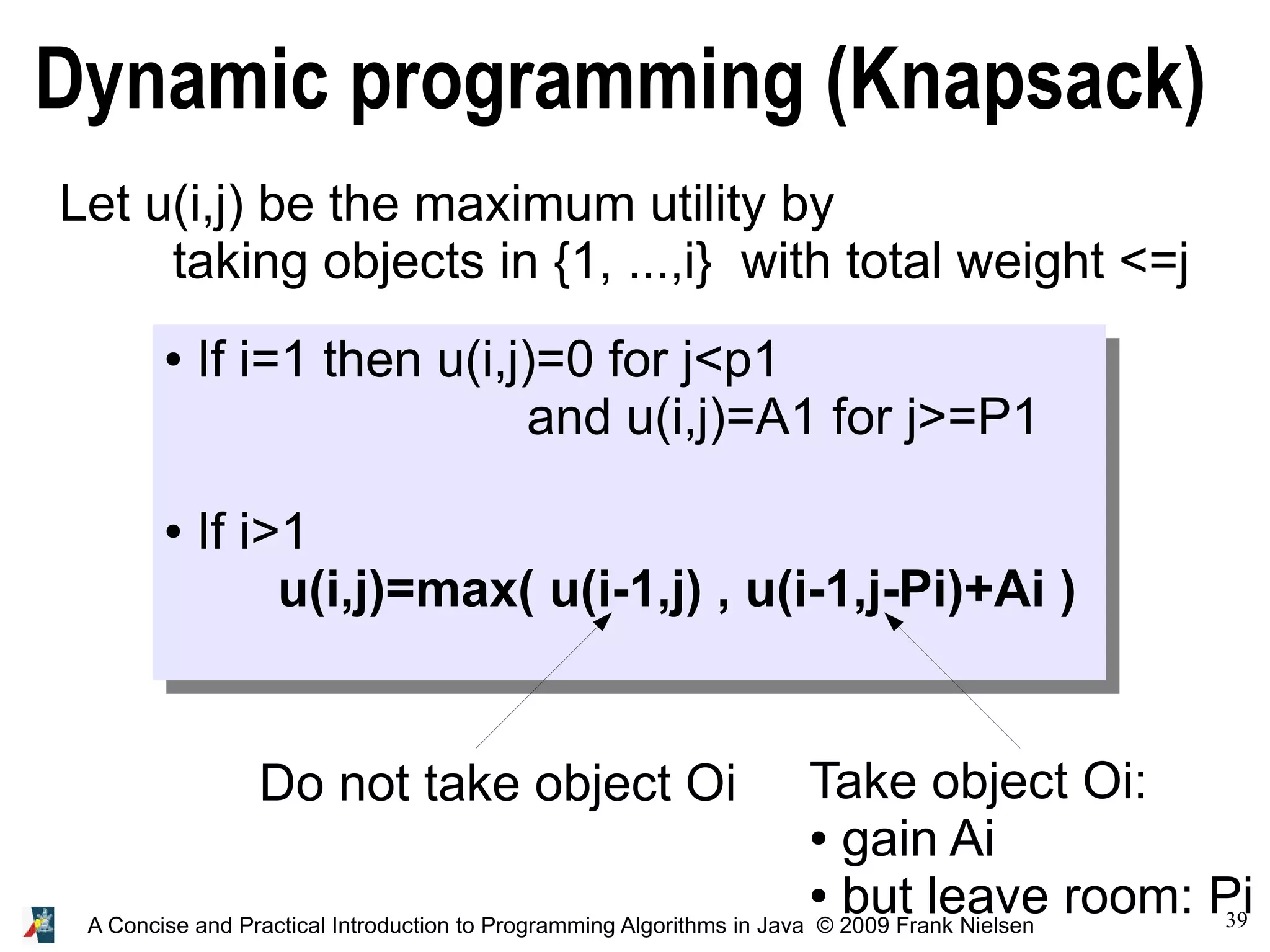
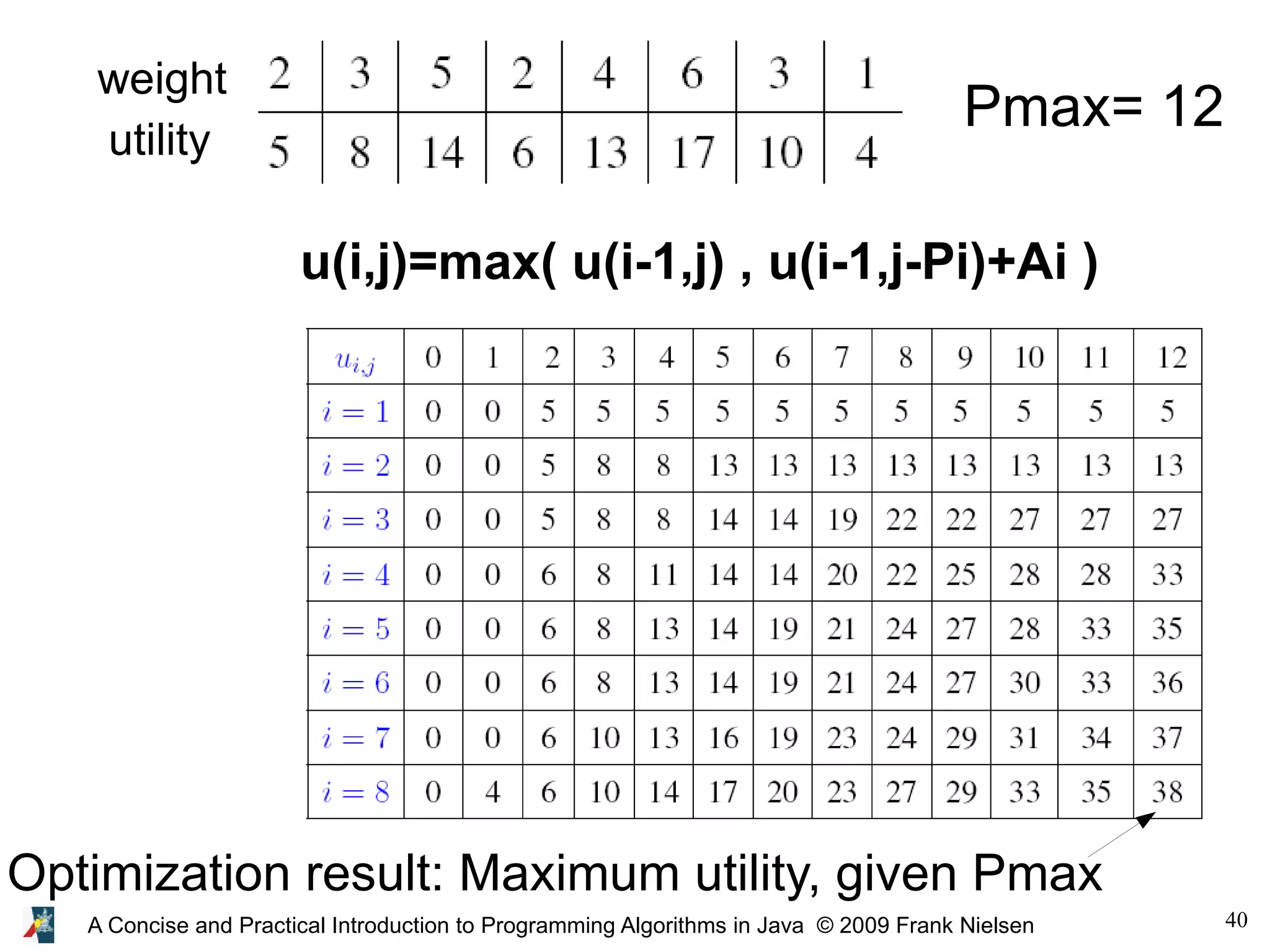
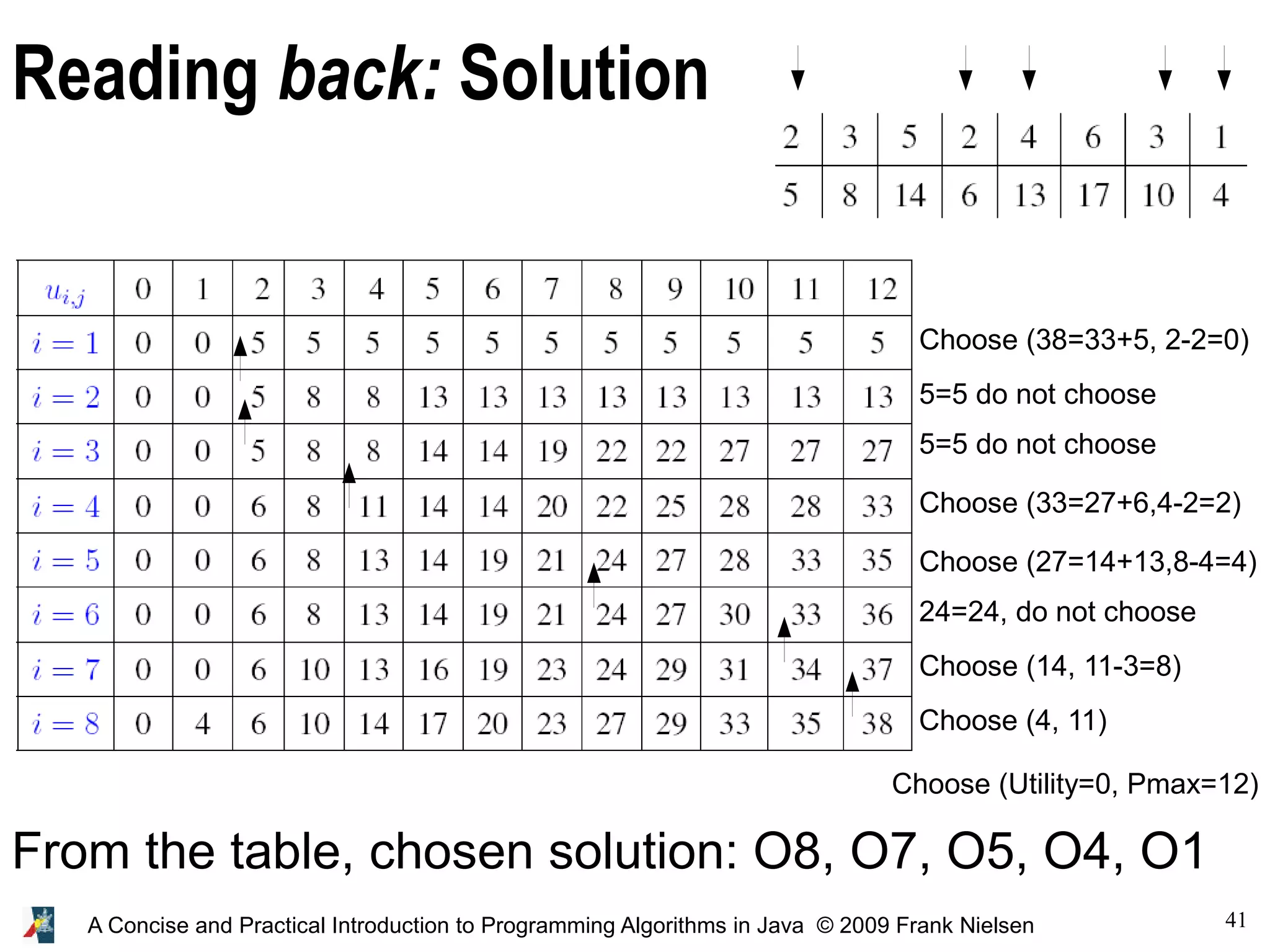
![42 A Concise and Practical Introduction to Programming Algorithms in Java © 2009 Frank Nielsen static int nbObjects=8; static int [] weight={2,3,5,2,4,6,3,1}; static int [] utility={5,8,14,6,13,17,10,4}; static int weightmax=12; static int [] [] array; static void SolveDP() { int i,j; array=new int[nbObjects][weightmax+1]; // initialize the first row for(j=0;j<=weightmax;j++) if (j<weight[0]) array[0][j]=0; else array[0][j]=utility[0]; // for all other rows for(i=1;i<nbObjects;i++) { for(j=0;j<=weightmax;j++) if (j-weight[i]<0) array[i][j]=array[i-1][j]; else array[i][j]=max( array[i-1][j], array[i-1][j-weight[i]]+utility[i]); } }](https://image.slidesharecdn.com/programmingalgorithmsjava-9-140701005620-phpapp01/75/chapter-9-A-Concise-and-Practical-Introduction-to-Programming-Algorithms-in-Java-42-2048.jpg)
![43 A Concise and Practical Introduction to Programming Algorithms in Java © 2009 Frank Nielsen static void InterpretArray() { int i,u,w; u=0; w=weightmax; for(i=nbObjects-1;i>=1;i--) { if (array[i][w]!=array[i-1][w]) {System.out.print((i+1)+" "); w=w-weight[i]; u=u+utility[i]; } } if (array[0][w]!=0); {System.out.println("1"); w=w-weight[0]; u=u+utility[0]; } System.out.println("Cross check:"+u+" remaining weight "+w); }](https://image.slidesharecdn.com/programmingalgorithmsjava-9-140701005620-phpapp01/75/chapter-9-A-Concise-and-Practical-Introduction-to-Programming-Algorithms-in-Java-43-2048.jpg)
![44 A Concise and Practical Introduction to Programming Algorithms in Java © 2009 Frank Nielsen public static void main(String[] args) { System.out.println("Solving knapsack using the dynamic programming paradigm."); SolveDP(); Display(); System.out.println("Reading solution:"); InterpretArray(); }](https://image.slidesharecdn.com/programmingalgorithmsjava-9-140701005620-phpapp01/75/chapter-9-A-Concise-and-Practical-Introduction-to-Programming-Algorithms-in-Java-44-2048.jpg)
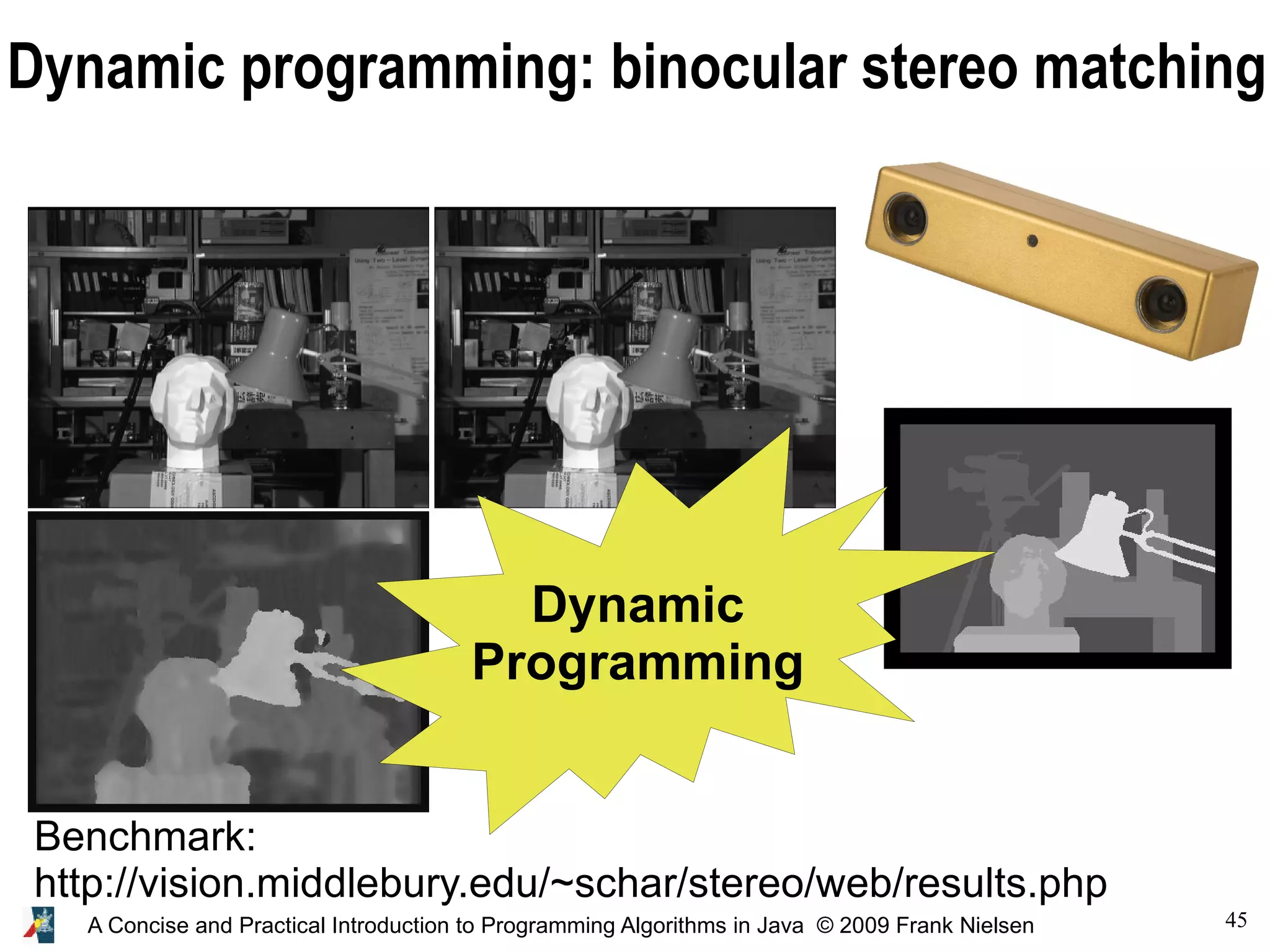
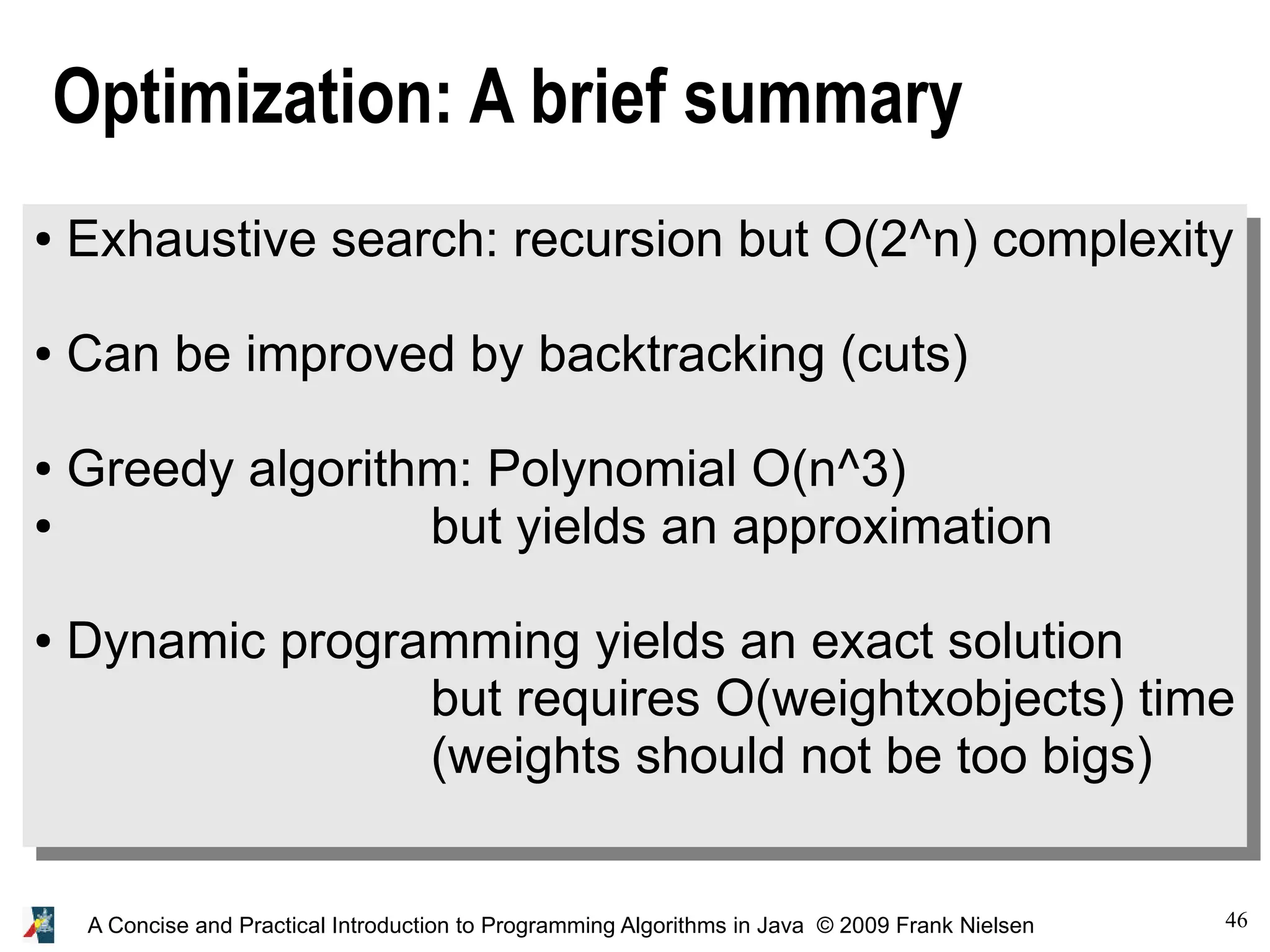
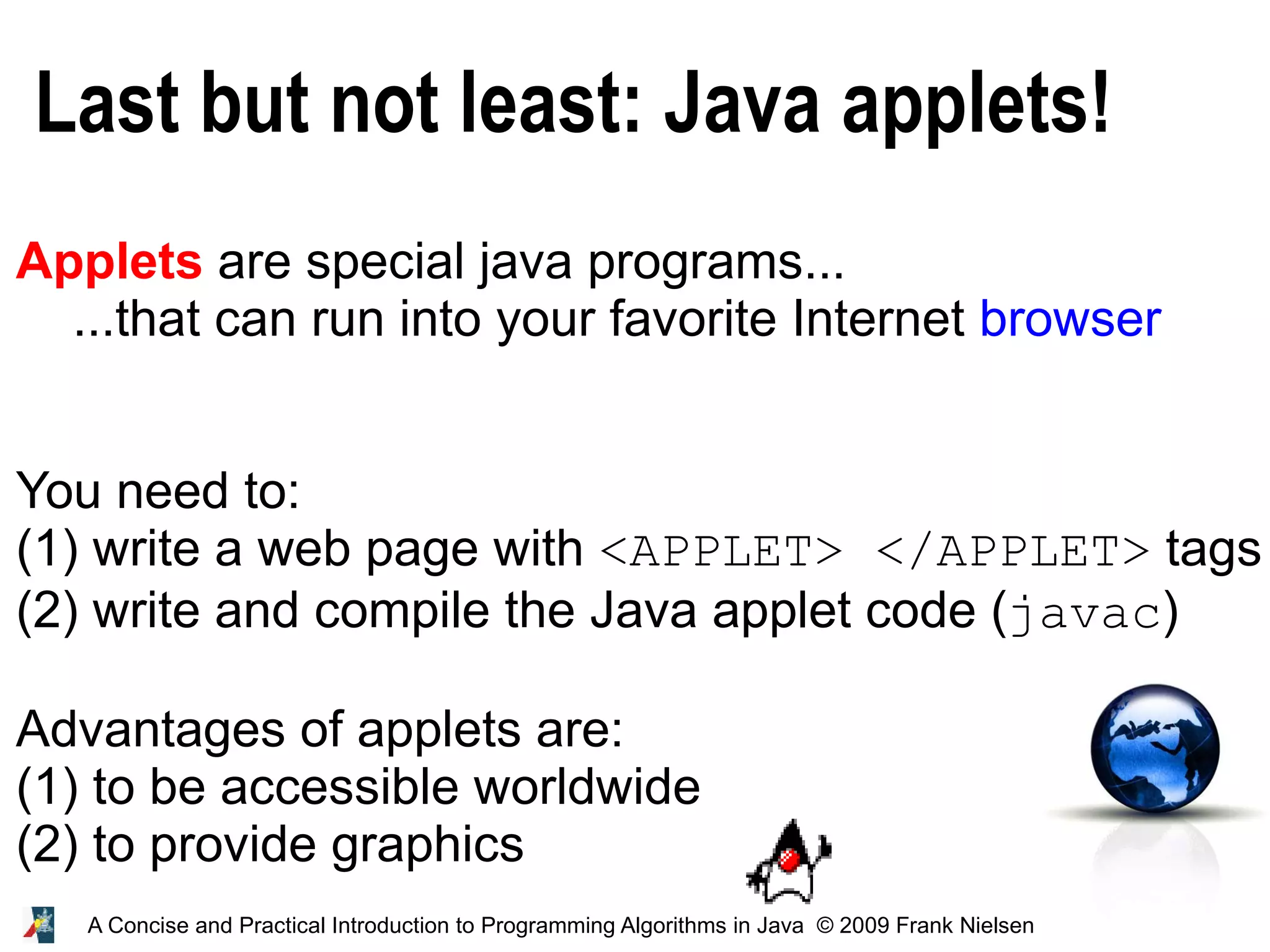
![48 A Concise and Practical Introduction to Programming Algorithms in Java © 2009 Frank Nielsen import java.awt.*; import java.applet.*; class Point2D {double x,y; Point2D() {this.x=300.0*Math.random(); this.y=300.0*Math.random();}} public class AppletINF311 extends Applet { final static int n=100; static Point2D [] set; public void init() { int i; set=new Point2D[n]; for(i=0;i<n;i++) set[i]=new Point2D();} public void paint(Graphics g) {int i; for(i=0;i<n;i++) { int xi, yi; xi=(int)set[i].x; yi=(int)set[i].y; g.drawRect(xi, yi,1,1); } g.drawString("INF311!", 50, 60 ); } }](https://image.slidesharecdn.com/programmingalgorithmsjava-9-140701005620-phpapp01/75/chapter-9-A-Concise-and-Practical-Introduction-to-Programming-Algorithms-in-Java-48-2048.jpg)
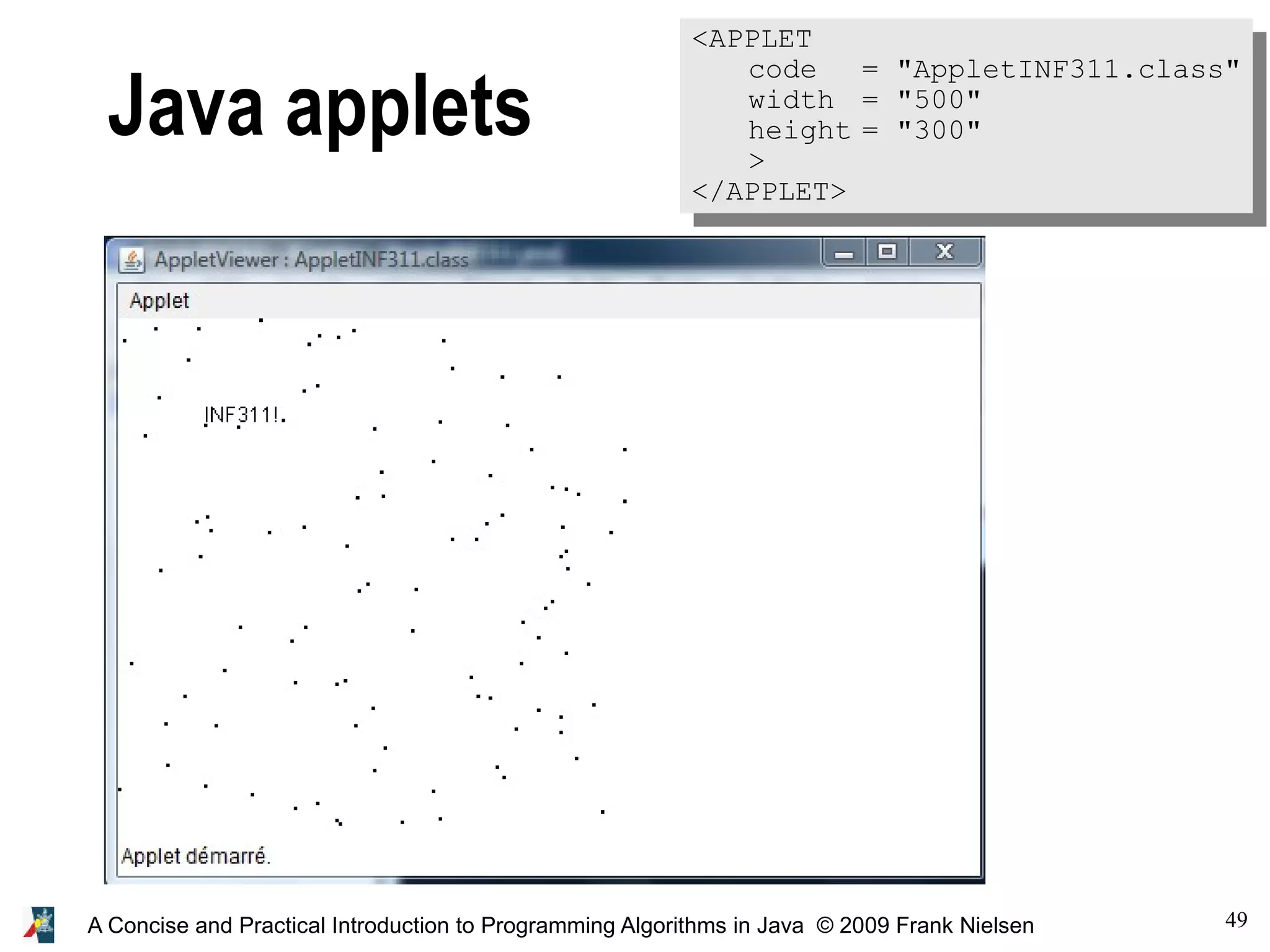
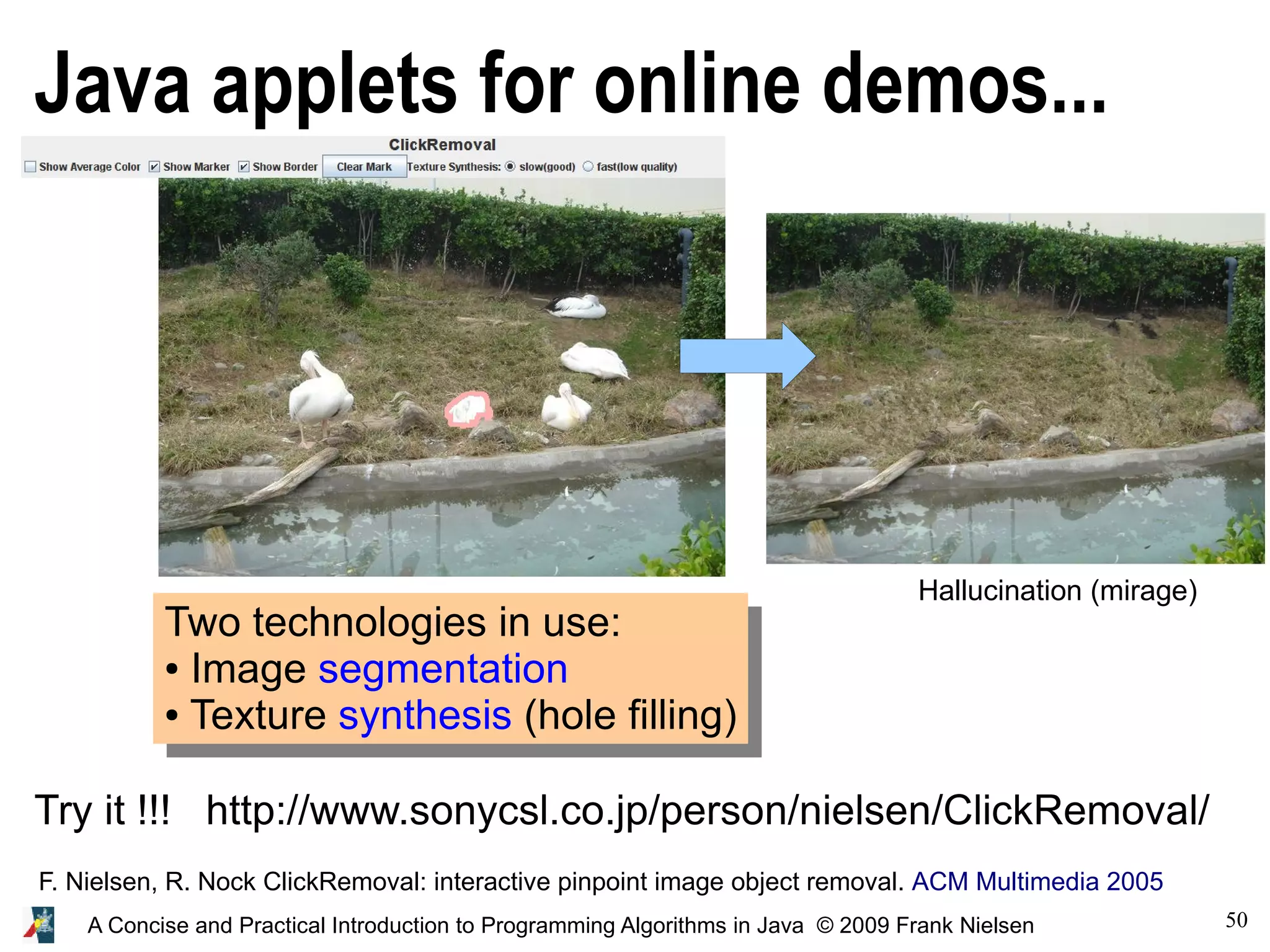
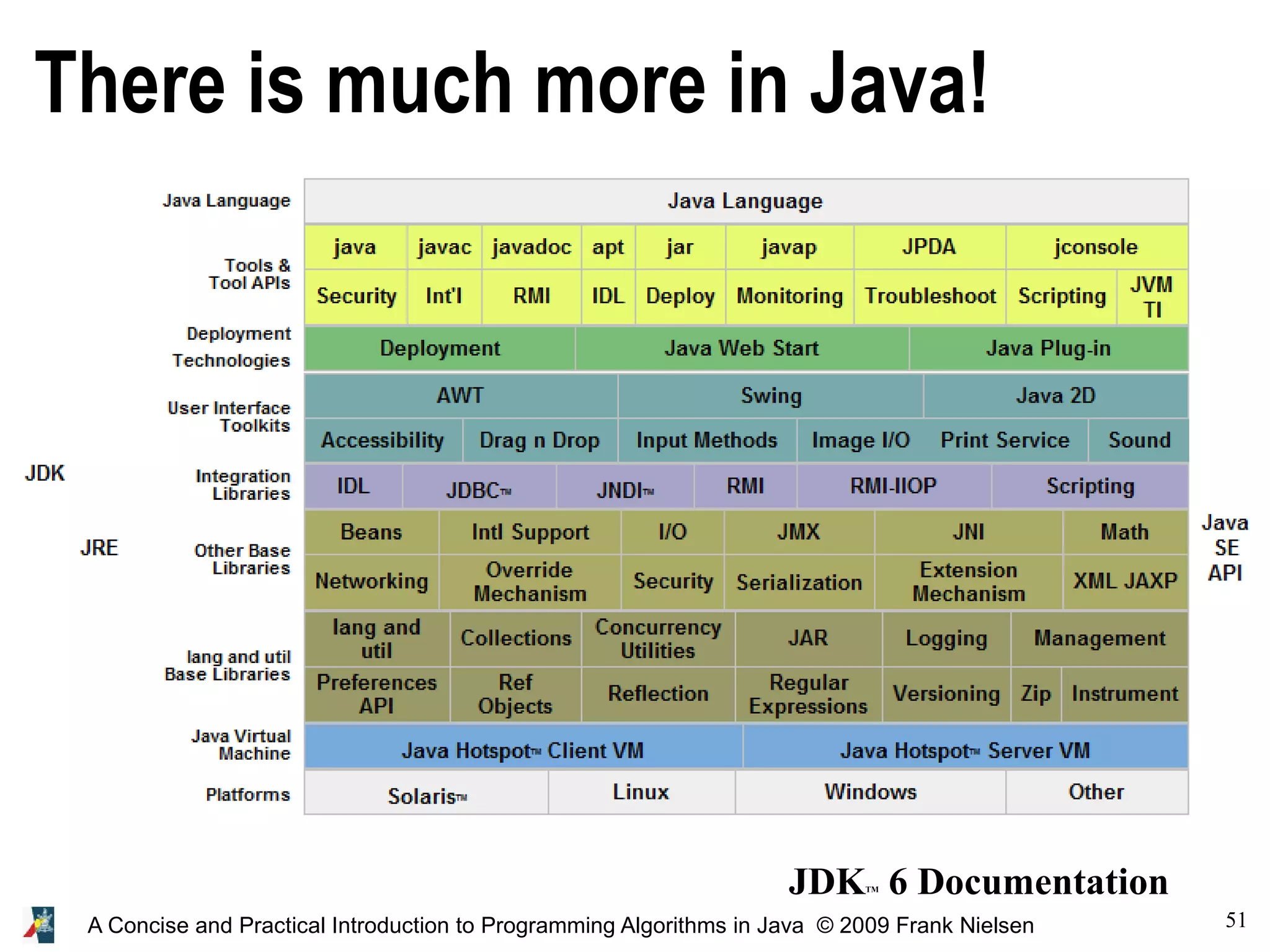
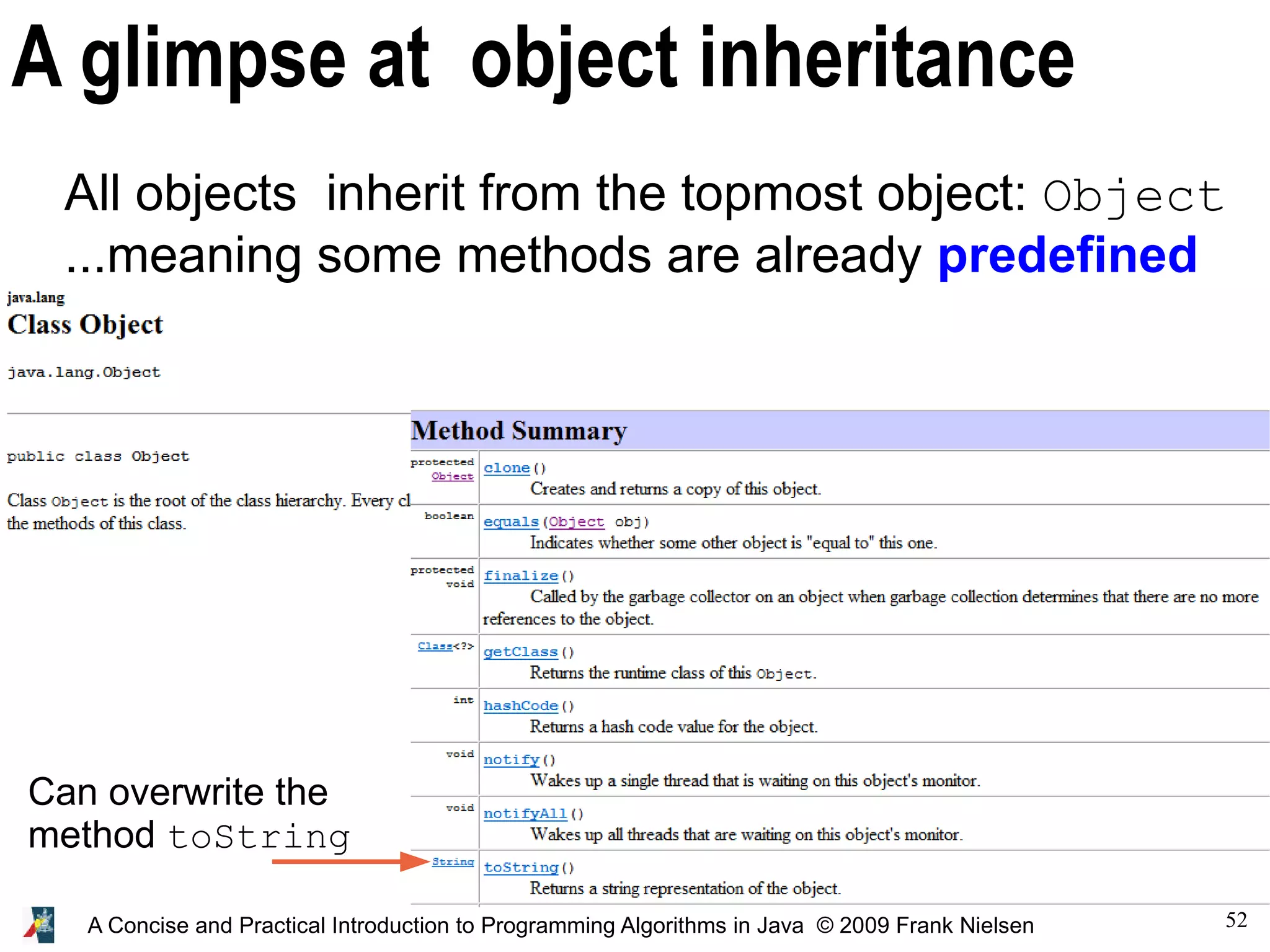
![53 A Concise and Practical Introduction to Programming Algorithms in Java © 2009 Frank Nielsen A glimpse at object inheritance Object public String toString() (superclass) Point2D public String toString() class Point2D {double x,y; // Constructor Point2D(double xi, double yi) {this.x=xi;this.y=yi; } // Overrides default method public String toString() {return "["+x+" "+y+"]"; } } class SuperClass { public static void main(String [] a) { Point2D myPoint=new Point2D(Math.PI, Math.E); System.out.println("Point:"+myPoint); } }](https://image.slidesharecdn.com/programmingalgorithmsjava-9-140701005620-phpapp01/75/chapter-9-A-Concise-and-Practical-Introduction-to-Programming-Algorithms-in-Java-53-2048.jpg)
